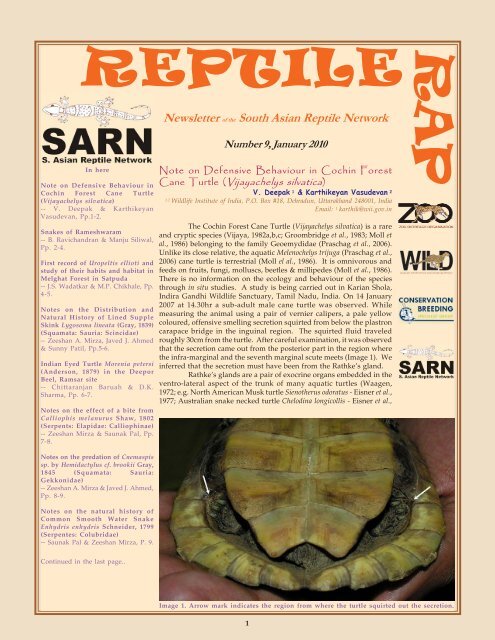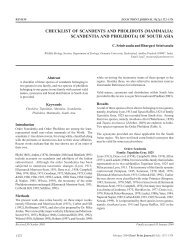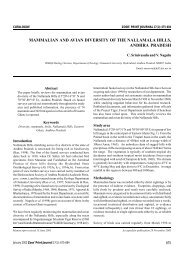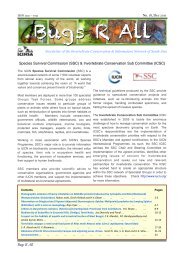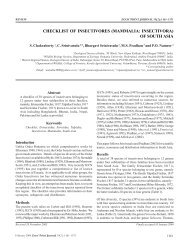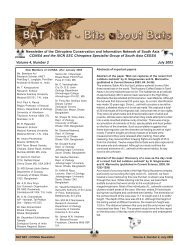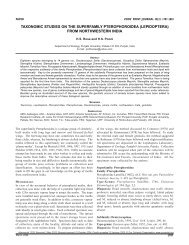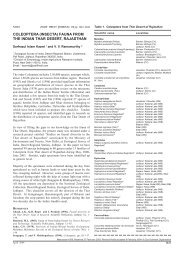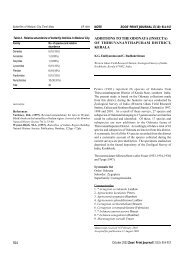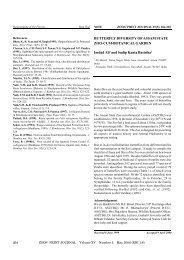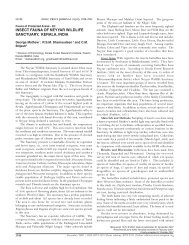Note on defensive behaviour in Cochin forest cane turtle - zoo's print
Note on defensive behaviour in Cochin forest cane turtle - zoo's print
Note on defensive behaviour in Cochin forest cane turtle - zoo's print
Create successful ePaper yourself
Turn your PDF publications into a flip-book with our unique Google optimized e-Paper software.
REPTILE RAP Newsletter of the South Asian Reptile Network # 9, January 2010REPTILEIn here<str<strong>on</strong>g>Note</str<strong>on</strong>g> <strong>on</strong> Defensive Behaviour <strong>in</strong>Coch<strong>in</strong> Forest Cane Turtle(Vijayachelys silvatica)-- V. Deepak & KarthikeyanVasudevan, Pp.1-2.Snakes of Rameshwaram-- B. Ravichandran & Manju Siliwal,Pp. 2-4.First record of Uropeltis ellioti andstudy of their habits and habitat <strong>in</strong>Melghat Forest <strong>in</strong> Satpuda-- J.S. Wadatkar & M.P. Chikhale, Pp.4-5.<str<strong>on</strong>g>Note</str<strong>on</strong>g>s <strong>on</strong> the Distributi<strong>on</strong> andNatural History of L<strong>in</strong>ed SuppleSk<strong>in</strong>k Lygosoma l<strong>in</strong>eata (Gray, 1839)(Squamata: Sauria: Sc<strong>in</strong>cidae)-- Zeeshan A. Mirza, Javed J. Ahmed& Sunny Patil, Pp.5-6.Indian Eyed Turtle Morenia petersi(Anders<strong>on</strong>, 1879) <strong>in</strong> the DeeporBeel, Ramsar site-- Chittaranjan Baruah & D.K.Sharma, Pp. 6-7.<str<strong>on</strong>g>Note</str<strong>on</strong>g>s <strong>on</strong> the effect of a bite fromCalliophis melanurus Shaw, 1802(Serpents: Elapidae: Callioph<strong>in</strong>ae)-- Zeeshan Mirza & Saunak Pal, Pp.7-8.Newsletter of the South Asian Reptile NetworkNumber 9, January 2010<str<strong>on</strong>g>Note</str<strong>on</strong>g> <strong>on</strong> Defensive Behaviour <strong>in</strong> Coch<strong>in</strong> ForestCane Turtle (Vijayachelys silvatica)V. Deepak 1 & Karthikeyan Vasudevan 21,2Wildlife Institute of India, P.O. Box #18, Dehradun, Uttarakhand 248001, IndiaEmail: 1 karthik@wii.gov.<strong>in</strong>The Coch<strong>in</strong> Forest Cane Turtle (Vijayachelys silvatica) is a rareand cryptic species (Vijaya, 1982a,b,c; Groombridge et al., 1983; Moll etal., 1986) bel<strong>on</strong>g<strong>in</strong>g to the family Geoemydidae (Praschag et al., 2006).Unlike its close relative, the aquatic Melenochelys trijuga (Praschag et al.,2006) <strong>cane</strong> <strong>turtle</strong> is terrestrial (Moll el al., 1986). It is omnivorous andfeeds <strong>on</strong> fruits, fungi, molluscs, beetles & millipedes (Moll et al., 1986).There is no <strong>in</strong>formati<strong>on</strong> <strong>on</strong> the ecology and <strong>behaviour</strong> of the speciesthrough <strong>in</strong> situ studies. A study is be<strong>in</strong>g carried out <strong>in</strong> Karian Shola,Indira Gandhi Wildlife Sanctuary, Tamil Nadu, India. On 14 January2007 at 14.30hr a sub-adult male <strong>cane</strong> <strong>turtle</strong> was observed. Whilemeasur<strong>in</strong>g the animal us<strong>in</strong>g a pair of vernier calipers, a pale yellowcoloured, offensive smell<strong>in</strong>g secreti<strong>on</strong> squirted from below the plastr<strong>on</strong>carapace bridge <strong>in</strong> the <strong>in</strong>gu<strong>in</strong>al regi<strong>on</strong>. The squirted fluid traveledroughly 30cm from the <strong>turtle</strong>. After careful exam<strong>in</strong>ati<strong>on</strong>, it was observedthat the secreti<strong>on</strong> came out from the posterior part <strong>in</strong> the regi<strong>on</strong> wherethe <strong>in</strong>fra-marg<strong>in</strong>al and the seventh marg<strong>in</strong>al scute meets (Image 1). We<strong>in</strong>ferred that the secreti<strong>on</strong> must have been from the Rathke’s gland.Rathke’s glands are a pair of exocr<strong>in</strong>e organs embedded <strong>in</strong> theventro-lateral aspect of the trunk of many aquatic <strong>turtle</strong>s (Waagen,1972; e.g. North American Musk <strong>turtle</strong> Sienotherus odoratus - Eisner et al.,1977; Australian snake necked <strong>turtle</strong> Chelod<strong>in</strong>a l<strong>on</strong>gicollis - Eisner et al.,RAP<str<strong>on</strong>g>Note</str<strong>on</strong>g>s <strong>on</strong> the predati<strong>on</strong> of Cnemaspissp. by Hemidactylus cf. brookii Gray,1845 (Squamata: Sauria:Gekk<strong>on</strong>idae)-- Zeeshan A. Mirza & Javed J. Ahmed,Pp. 8-9.<str<strong>on</strong>g>Note</str<strong>on</strong>g>s <strong>on</strong> the natural history ofComm<strong>on</strong> Smooth Water SnakeEnhydris enhydris Schneider, 1799(Serpentes: Colubridae)-- Saunak Pal & Zeeshan Mirza, P. 9.C<strong>on</strong>t<strong>in</strong>ued <strong>in</strong> the last page..Image 1. Arrow mark <strong>in</strong>dicates the regi<strong>on</strong> from where the <strong>turtle</strong> squirted out the secreti<strong>on</strong>.1
REPTILE RAP Newsletter of the South Asian Reptile Network # 9, January 20101998; Kemp’s Ridley <strong>turtle</strong> Lepidochelys kempi - Weld<strong>on</strong> et al.,1990; Green <strong>turtle</strong> Chel<strong>on</strong>ia mydas - Solom<strong>on</strong>, 1984; Loggerhead<strong>turtle</strong> Caretta caretta - Weld<strong>on</strong> & Tanner, 1990). Secreti<strong>on</strong>s fromthese glands are made through duct open<strong>in</strong>gs <strong>in</strong> the axillary,<strong>in</strong>framarg<strong>in</strong>al or <strong>in</strong>gu<strong>in</strong>al regi<strong>on</strong>s, when <strong>turtle</strong>s are disturbed.It is hypothesized that these secreti<strong>on</strong>s repel predators becauseof their offensive smell (e.g. Ehrenfeld & Ehrenfeld, 1973).Moll et al. (1986) described two forms of <strong>defensive</strong><strong>behaviour</strong> <strong>in</strong> the Coch<strong>in</strong> <strong>forest</strong> <strong>cane</strong> <strong>turtle</strong>. In the first form amale-to-male combat was observed <strong>in</strong> captivity and a largermale moved towards a small male with its neck extended andmouth open. The small male defended itself by retract<strong>in</strong>g itshead and tipped the anterior porti<strong>on</strong> of its carapace towardsthe aggressor. This k<strong>in</strong>d of <strong>defensive</strong> <strong>behaviour</strong> may be <strong>in</strong>traspecific<strong>in</strong> nature. The sec<strong>on</strong>d form of <strong>defensive</strong> <strong>behaviour</strong>was observed <strong>in</strong> both the sexes. The <strong>cane</strong> <strong>turtle</strong>s defecatedfrequently when picked up from the ground and the malealso extended its penis. We suspect that these <strong>defensive</strong><strong>behaviour</strong> deter predators. The present observati<strong>on</strong> <strong>in</strong>dicatesthe third form of <strong>defensive</strong> <strong>behaviour</strong> <strong>in</strong> the species. Throughthis report we highlight the diversity of defense mechanisms<strong>in</strong> the species and emphasize the need to observe their<strong>behaviour</strong> <strong>in</strong> situ.Ehrenfeld, J.G. & D.W. Ehrenfeld (1973). Externally secret<strong>in</strong>gglands of freshwater and sea <strong>turtle</strong>s. Copeia 1973: 305-314.Eisner T., W.E. C<strong>on</strong>ner, K. Hicks, K.R. Dodge, H.I. Rosenberg,T.H. J<strong>on</strong>es, M. Cohen & J. Me<strong>in</strong>wald (1977). St<strong>in</strong>k of the st<strong>in</strong>kpotidentified: ù1-phenylalkanoic acids. Science 196: 1347-1349.Eisner T., T. H. J<strong>on</strong>es, J. Me<strong>in</strong>wald & J. M. Legler (1978).Chemical compositi<strong>on</strong> of the odorous secreti<strong>on</strong> of the Australian<strong>turtle</strong>, Chelod<strong>in</strong>a I<strong>on</strong>gicollis. Copeia 1978: 714-715.Groombridge, B., E.O. Moll & J. Vijaya (1983). Rediscovery of arare Indian <strong>turtle</strong>. Oryx 17: 30–34.Moll, E.O., B. Groombridge & J. Vijaya (1986). Rediscovery of the<strong>cane</strong> <strong>turtle</strong> with notes <strong>on</strong> its natural history and classificati<strong>on</strong>. Journalof Bombay Natural History Society 83(Supplement): 112–126.Vijaya, J. (1982a). Rediscovery of the <strong>forest</strong> <strong>cane</strong> <strong>turtle</strong> (Heosemyssilvatica) of Kerala. Hamadryad 7: 2–3.Vijaya, J. (1982b). Rediscovery of the <strong>forest</strong> <strong>cane</strong> <strong>turtle</strong>, Heosemys(Geoemyda) silvatica (Reptilia, Testud<strong>in</strong>ata, Emydidae) fromChalakudy Forests <strong>in</strong> Kerala. Journal of Bombay Natural History Society79: 676–677.Vijaya, J. (1982c). Rediscovery of a rare <strong>turtle</strong> from Kerala Forest.Hornbill 4: 25 –26.Praschag, P., C. Schmidt, G. Fritzsch, A. Muller, R. Gemel & U.Fritz (2006). Geoemyda silvatica, an enigmatic <strong>turtle</strong> of theGeoemydidae (Reptilia: Testud<strong>in</strong>es), represents a dist<strong>in</strong>ct genus.Organisms, Diversity & Evoluti<strong>on</strong> 6: 151-162.Solom<strong>on</strong> S.E. (1984). The characterisati<strong>on</strong> and distributi<strong>on</strong> of cellsl<strong>in</strong><strong>in</strong>g the axillary gland of the adult green <strong>turtle</strong> (Chel<strong>on</strong>ia mydasL.). Journal of Anatomy 138: 267-279.Waagen G.N. (1972). Musk glands <strong>in</strong> Recent <strong>turtle</strong>s. Thesis,University of Utah, UT, USA.Weld<strong>on</strong> P.J. & M.J. Tanner (1990). Lipids <strong>in</strong> the Rathke’s glandsecreti<strong>on</strong>s of hatchl<strong>in</strong>g loggerhead sea <strong>turtle</strong>s (Caretta caretta). Copeia1990: 570-573.Weld<strong>on</strong> P.J., R.T. Mas<strong>on</strong>, M.J. Tanner & T. Eisner (1990). Lipids<strong>in</strong> the Rathke’s gland secreti<strong>on</strong>s of hatchl<strong>in</strong>g Kemp’s Ridley sea<strong>turtle</strong>s (Lepidochelys kempi). Comparative Biochemistry and Physiology96B (4): 705-708.Acknowledgements: This study is supported by the WildlifeInstitute of India Grants-<strong>in</strong>-aid for Research. The Tamil Nadu andKerala State Forest Departments are thanked for support<strong>in</strong>g the study.Silamban and Rajan are thanked for their assistance <strong>in</strong> the field. BivashPandav, Thirthu Dutta and Harikrishnan are thanked for their <strong>in</strong>puts<strong>in</strong> the study.Snakes of RameshwaramB. Ravichandran 1 & Manju Siliwal 21Zoo Outreach Organisati<strong>on</strong>, 2 Wildlife Informati<strong>on</strong> Liais<strong>on</strong>Development Society, 9-A, Lal Bahadur Col<strong>on</strong>y, Peelamedu,Coimbatore, Tamil Nadu 641004, IndiaEmail: 1 ravi@zooreach.org, 2 manju@zooreach.orgRameshwaram is a town <strong>in</strong> Ramanathapuram District<strong>in</strong> Tamil Nadu. It is located <strong>on</strong> an island separated fromma<strong>in</strong>land India by the Pamban channel and is less than 40kmfrom Sri Lanka. Rameshwaram is located at 9.280N-79.30E. Ithas an average elevati<strong>on</strong> of 10m (32ft). The island is spreadover an area of 61.8sq.km and happens to be <strong>in</strong> the shape of ac<strong>on</strong>ch.Rameswaram has a dry tropical climate withtemperatures around 30-350C, the highest ever recorded atPamban stati<strong>on</strong> is 37°C and lowest 170C. The average annualra<strong>in</strong>fall is 94cm, received mostly from the North East m<strong>on</strong>so<strong>on</strong>between October and January.There is no <strong>in</strong>formati<strong>on</strong> available <strong>on</strong> snakes ofRameshwaram. Dur<strong>in</strong>g our work <strong>on</strong> tarantulas (Parachutespiders) of Rameshwaram Island, we came across five speciesof snakes. The snake species spotted were Saw-scaled Viper(Echis car<strong>in</strong>atus), Bridal Snake (Dryocalamus nympha), Red SandBoa (Eryx johnii)), Russell’s Kukri (Oligod<strong>on</strong> taeniolatus) andComm<strong>on</strong> Wolf Snake (Lycod<strong>on</strong> aulicus). We did not catch thesnakes as we do not have the necessary tra<strong>in</strong><strong>in</strong>g to handlesnakes to handle the snakes. We however took photographsof the snakes. Dr. S. Bhupathy helped us to identify the snakes.Sea sand covers most of the island of Rameshwaramwith hardly any other arable land. Plantati<strong>on</strong>s of Tamar<strong>in</strong>d(Tamar<strong>in</strong>dus <strong>in</strong>dicus), Coc<strong>on</strong>ut (Cocos nucifera) and Palm(Borassus flabellifer) are comm<strong>on</strong>. We c<strong>on</strong>ducted our workmostly <strong>in</strong> Tamar<strong>in</strong>d, Casuar<strong>in</strong>a (Casuar<strong>in</strong>aceae equisetifolia) andPalm groves. Tamar<strong>in</strong>d and Palm trees grow together <strong>in</strong> mostplaces. The Casuar<strong>in</strong>a groves are 10-12kms <strong>in</strong> length and 1-2kms <strong>in</strong> width.We visited Rameshwaram n<strong>in</strong>e times between 2004and 2007. We sighted 5-6 snakes dur<strong>in</strong>g each of our fieldvisits. Apart from snakes, we saw scorpi<strong>on</strong>s, the Tree Frog(Kaloula pulchra), House Centipede (Scutigera coleoptrata), WhipSpider, termite and bark geckos.Saw-scaled Viper (Echis car<strong>in</strong>atus) (Image 1): Ma<strong>in</strong>lynocturnal, usually basks <strong>in</strong> the morn<strong>in</strong>g sun. Mostly found <strong>in</strong>open dry, sandy or rocky terra<strong>in</strong> <strong>in</strong> the pla<strong>in</strong>s and hills, andalso <strong>in</strong> open, rocky regi<strong>on</strong>s with heavy ra<strong>in</strong>fall; It rests underrocks, beh<strong>in</strong>d tree trunks and at the base of thorny plantsdur<strong>in</strong>g the day. The average size of the snake is 12-20cm. It isa highly venomous snake with venom be<strong>in</strong>g very toxic(Whitaker & Capta<strong>in</strong>, 2004).Image 1. Saw-scaled Viper (Echis car<strong>in</strong>atus)2
REPTILE RAP Newsletter of the South Asian Reptile Network # 9, January 2010Table 1. Snakes sighted dur<strong>in</strong>g our visits.Date of visit Saw-scaled Viper Bridal Snake Red Sand Boa Russell’s Kukri Comm<strong>on</strong> Wolf SnakeEchis car<strong>in</strong>atus Dryocalamus nympha Eryx johnii Oligod<strong>on</strong> taeniolatus Lycod<strong>on</strong> aulicusSep – Oct 2004 + + +Nov – Dec 2004 + + +June – Jul 2005 + - +Sep – Oct 2005 + + +May – June 2006 + + + +Aug 2006 + + +Nov – Dec 2006 + + + +, + +Feb 2007 + + +Nov – Dec 2007 + + +It is <strong>on</strong>e of the comm<strong>on</strong> snakes of Rameshwaram.We recorded this snake <strong>in</strong> all our field visits. It was foundacross all plantati<strong>on</strong>s, irrespective of the tree species. Wespotted this snake species <strong>on</strong> the ground, example under thebark of Casuar<strong>in</strong>a, yamar<strong>in</strong>d and <strong>in</strong>side the fr<strong>on</strong>ds of youngpalm trees. We spotted this snake both dur<strong>in</strong>g the day andnight. Dur<strong>in</strong>g the day, it was found under the bark and underthe roots of Casuar<strong>in</strong>a and dur<strong>in</strong>g the night, it was seenmov<strong>in</strong>g <strong>on</strong> the ground. At every visit we recorded a m<strong>in</strong>imumof 3-4 snakes.Bridal Snake (Dryocalamus nympha) (Image 2):Smooth-scaled, dark brown or black back with creamish-whitebands that widen <strong>on</strong> the sides and break up <strong>on</strong> h<strong>in</strong>d body.Poorly known, nocturnal, found <strong>in</strong> pla<strong>in</strong>s and low hills, and aImage 3. Red Sand Boa (Eryx johnii)Image 2. Bridal Snake (Dryocalamus nympha)good climber. The maximum size of the snake is 21<strong>in</strong>. It is an<strong>on</strong> venomous snake (Whitaker & Capta<strong>in</strong>, 2004).We recorded this snake eight times out of n<strong>in</strong>e visits.Accord<strong>in</strong>g to Whitaker and Capta<strong>in</strong> (2004) it has not beenrecorded near coastal areas, <strong>on</strong>ly <strong>in</strong>terior parts of the ma<strong>in</strong>land.This is the first record <strong>in</strong> a coastal area. We found this snakespecies <strong>in</strong> tamar<strong>in</strong>d and palm groves dur<strong>in</strong>g our night surveys.Once we observed a young Bridal Snake al<strong>on</strong>g with a parachutespider <strong>in</strong> a palm tree, the snake was less than 15cm. It wentbeh<strong>in</strong>d the bark of palm tree. Even though they were bothvery close to each other (less than 10cm), they did not <strong>in</strong>teractwith each other.Red Sand Boa (Eryx johnii) (Image 3): Thick-bodied.Head th<strong>in</strong>ner than neck; with a wide, shovel-shaped scale atthe tip of the snout. Nocturnal, prefers dry places and sandysoils. Often lives <strong>in</strong> rodent burrows. Kills most prey byc<strong>on</strong>stricti<strong>on</strong>. The maximum size of the snake is 39<strong>in</strong>. It is an<strong>on</strong> venomous snake (Whitaker & Capta<strong>in</strong>, 2004).Dur<strong>in</strong>g our surveys we recorded this snake twice.We sighted this species <strong>in</strong> two different places <strong>in</strong>Rameshwaram. It was <strong>on</strong> the sand and mov<strong>in</strong>g very slowly.Russell’s Kukri (Oligod<strong>on</strong> taeniolatus) (Image 4):Scales smooth, head slightly or not broader than neck, withtypical ^ shaped marks seen <strong>on</strong> most kukri snakes. Thoughactive both by day and night, frequently seen at dusk. FoundImage 4. Russell’s Kukri (Oligod<strong>on</strong> taeniolatus)Image 5. A Cat Snake Oligod<strong>on</strong> sp. <strong>on</strong> Rameshwaram Island<strong>in</strong> <strong>forest</strong>s as well as near human habitati<strong>on</strong>. Climbs well. Themaximum size of the snake is 23<strong>in</strong>. It is a n<strong>on</strong> venomoussnake (Whitaker & Capta<strong>in</strong>, 2004).We recorded this snake twice. We saw this snake <strong>on</strong>the ground at night, it moved very fast when it was disturbed.Dur<strong>in</strong>g the day time we found this snake <strong>in</strong>side the tree hole3
REPTILE RAP Newsletter of the South Asian Reptile Network # 9, January 2010Table 1. Scalati<strong>on</strong> data of three dead specimens of Uropeltis elliotiSp.No. Date of found Length Diameter Body Scales Ventral Subcaudal01 29/07/2006 166mm 18mm 17-17 smooth 151 10 divided02 13/08/2006 220mm 26mm 17-17 smooth 156 06 divided03 10/10/2006 180mm 20mm 17-17 smooth 152 07 dividedElliots Shieldtail UP Cephalic endElliots Shieldtail <strong>in</strong> lifeElliots Shieldtail UP anal endElliots Shieldtail UN Tailand Mr. Ashok Capta<strong>in</strong>, Renowned Herpetologist for theircooperati<strong>on</strong> time to time. I am thankful to Prof. Dr. G.N. Vankhede,Head, Department of Zoology, S.G.B. Amravati University,Amravati for c<strong>on</strong>t<strong>in</strong>uous <strong>in</strong>spirati<strong>on</strong>. My thanks are due to myfriend Mr. Yadav Tarte who accompanied dur<strong>in</strong>g surveys <strong>in</strong> Melghat.<str<strong>on</strong>g>Note</str<strong>on</strong>g>s <strong>on</strong> the Distributi<strong>on</strong> and NaturalHistory of L<strong>in</strong>ed Supple Sk<strong>in</strong>k Lygosomal<strong>in</strong>eata (Gray, 1839) (Squamata: Sauria:Sc<strong>in</strong>cidae)Zeeshan A. Mirza 1 , Javed J. Ahmed 2 & Sunny Patil 311-13 Shiv Col<strong>on</strong>y, Marol Police Camp, Andheri (East), Mumbai,Maharashtra 400059, India; 2 A-3/ Flat no. H-8, Panchavati Hous<strong>in</strong>gSociety, Marol Maroshi Road, Andheri (East), Mumbai, Maharashtra400059, India; 3 C-25, B w<strong>in</strong>g, 101, Gokuldham, Gorega<strong>on</strong> (east),Mumbai, Maharashtra 400063, IndiaEmail: snakeszeeshan@gmail.com 1 , syngnathid@gmail.com 2 ,sunny22@gmail.com 3The L<strong>in</strong>ed Supple Sk<strong>in</strong>k Chiamela l<strong>in</strong>eata was describedby Gray <strong>in</strong> 1869 without any specific locality. Later Boulenger,1887 allocated it to the genus Lygosoma. This species wasreported to occur <strong>in</strong> Bombay district between Po<strong>on</strong>a and northKanara (Smith, 1935). It was later reported fromChidambaram district, Tamil Nadu and Salsette Island (Chari,1960) and Gujarat state (Naik & V<strong>in</strong>od, 1994), (Gayel, 1999)and (Vyas, 2001). Vyas (2001) suggested L. vosmaerii (Gray,1839) as a syn<strong>on</strong>ym under L. l<strong>in</strong>eata (Gray, 1839). Das (1997)menti<strong>on</strong>s L. vosmaerii <strong>in</strong> his checklist; whereas Das (2003) doesnot menti<strong>on</strong> it <strong>in</strong> his list of updated reptile tax<strong>on</strong>omy andnomenclature. If the type locality of L. vosmaerii (Gray, 1839)be<strong>in</strong>g a syn<strong>on</strong>ymy under L. l<strong>in</strong>eata (Gray, 1839) is correct(Bengal), than L. l<strong>in</strong>eata probably occurs <strong>in</strong> Bengal as well.We observed several live specimens at Mumbai,Khopoli, Kolad, Nashik and Phansad Wild Life Sanctuary <strong>in</strong>Maharashtra from the year 2005 to 2007. In Mumbai it hasbeen found at Aarey Milk Col<strong>on</strong>y (19o9’57"N-72o51’32’’E), FilmCity (19o9’46’’N-72o53’31’’E), Marol (19o7’31’’N-72o52’76’’E)and Sanjay Gandhi Nati<strong>on</strong>al Park (Borivali). This shows thatthis species occurs not <strong>on</strong>ly <strong>in</strong> the Western and Eastern Ghats,but also <strong>in</strong> Gujarat and may <strong>in</strong>deed be a more wide spreadspecies than collecti<strong>on</strong> records <strong>in</strong>dicate. Here we take theopportunity to add some data <strong>on</strong> the natural history of thislittle known lizard based <strong>on</strong> specimens observed <strong>in</strong> parts ofMaharashtra.Lygosoma l<strong>in</strong>eata is mostly found under rocks, underdriftwood and am<strong>on</strong>g leaf litter with other sympatric specieslike Calliophis melanurus, Eutropis car<strong>in</strong>ata, Eutropis maculariaand Ramphotyphlops bram<strong>in</strong>us. The L<strong>in</strong>ed Supple sk<strong>in</strong>k alsooccurs <strong>in</strong> coastal <strong>forest</strong>s of Phansad Wildlife Sanctuary up tohilly regi<strong>on</strong>s of Khopoli and Kolad with altitudes rang<strong>in</strong>gfrom 150-457m. In Mumbai it is found <strong>in</strong> varied habitats suchas <strong>forest</strong>s, grass and scrub areas and also <strong>in</strong> gardens. It wascomm<strong>on</strong>ly observed actively forag<strong>in</strong>g around termite mounds<strong>in</strong> the early morn<strong>in</strong>gs and late even<strong>in</strong>gs. A total of fivespecimens were found tak<strong>in</strong>g refuge under large boulders <strong>on</strong>the slope of a small hillock <strong>in</strong> an area of less than 1000ft².Adults are golden brown above, with each scale marked witha central black dot form<strong>in</strong>g l<strong>on</strong>gitud<strong>in</strong>al l<strong>in</strong>es from head totail tip. Two juveniles possess<strong>in</strong>g navy blue tails were found<strong>in</strong> Mumbai, measur<strong>in</strong>g ca. 20mm TBL. It has been found nearant hills and termite mounds. One <strong>in</strong>dividual measur<strong>in</strong>g58mm TBL was reta<strong>in</strong>ed for observati<strong>on</strong> <strong>in</strong> captivity for 45days with filter sand as the substrate and fed up<strong>on</strong> termites,house flies and mosquitoes, even accept<strong>in</strong>g prey5
REPTILE RAP Newsletter of the South Asian Reptile Network # 9, January 2010approximately thrice the size of its head, which were activelypursued and subdued by hitt<strong>in</strong>g aga<strong>in</strong>st the substrate prior tobe<strong>in</strong>g c<strong>on</strong>sumed. The <strong>in</strong>dividual was also observedswallow<strong>in</strong>g sand gra<strong>in</strong>s, probably to aid the digesti<strong>on</strong> process.A specimen captured whilst c<strong>on</strong>sum<strong>in</strong>g a Brahm<strong>in</strong>y WormSnake Ramphotyphlops bram<strong>in</strong>us regurgitated it, probablyow<strong>in</strong>g to the stress of capture. Lygosoma l<strong>in</strong>eata is probablypreyed up<strong>on</strong> by sympatric predators like Giant CentipedesScolopendra sp., Slender Coral Snake Calliophis melanurus, andCantors Black Headed Snake Sibynophis subpunctatus. Thoughnot a rare lizard as previously reported to be (Naik & V<strong>in</strong>od,1994), its numbers are <strong>in</strong> decl<strong>in</strong>e ow<strong>in</strong>g to loss of habitat.Chari, V.K. (1960). Distributi<strong>on</strong> of sk<strong>in</strong>k Riopa l<strong>in</strong>eata Gray. Journalof the Bombay Natural History Society 57: 226.Daniel, J.C. (2002). The Book of Indian Reptiles and Amphibians.Bombay Natural History Society and Oxford University Press.Mumbai. viii +238pp.Das, I. (2003). Growth of knowledge <strong>on</strong> the reptiles of India, withan <strong>in</strong>troducti<strong>on</strong> to Systematics, Tax<strong>on</strong>omy and Nomenclature.Journal of the Bombay Natural History Society 100(2&3): 446-501.Das, I. (1997). Checklist of the reptiles of India with English comm<strong>on</strong>names. Hamadryad 22: 32-45.Gayen, N.C. (1999). A synopsis of the reptiles of Gujarat, westernIndia. Hamadryad 24(1): 1-22.Gunther, A.C.L.G. (1864). The Reptiles of British India. RobertHardwicke, L<strong>on</strong>d<strong>on</strong>, xxvii + 452pp. 26pl.Naik, Y.M. & K.R. V<strong>in</strong>od (1994). Record of a rare sk<strong>in</strong>k Lygosomal<strong>in</strong>eata (Gray) from Kevadia, Gujarat. Journal of the Bombay NaturalHistory Society 91: 324-325.Smith, M.A. (1935). Fauna of British India, <strong>in</strong>clud<strong>in</strong>g Ceyl<strong>on</strong> andBurma. Reptilia and Amphibia. Vol. II. - Sauria. Taylor and Francis.L<strong>on</strong>d<strong>on</strong>, xiii+440pp+1pl.Vyas, R. (2001). <str<strong>on</strong>g>Note</str<strong>on</strong>g>s <strong>on</strong> the distributi<strong>on</strong> of Lygosoma l<strong>in</strong>eata (Gray,1839) and comments <strong>on</strong> the systematic status of Lygosoma vosmaerii(Gray, 1839). Hamadryad 26(2): 360-361.Acknowledgment: I would like to thank Sach<strong>in</strong> Rai forhis photograph and also Jack<strong>in</strong>, Gav<strong>in</strong> Desouza and Kunal Ullalkar.Indian Eyed Turtle Morenia petersi (Anders<strong>on</strong>,1879) <strong>in</strong> the Deepor Beel, Ramsar siteChittaranjan Baruah 1 & D.K. Sharma 21,2Center for Wildlife Research and C<strong>on</strong>servati<strong>on</strong> Acti<strong>on</strong> (CWRCA),Department of Zoology (UGC-SAP & DST-FIST sp<strong>on</strong>soredDepartment), Gauhati University, Guwahati, Assam 781 014, IndiaEmail: 1 chittaranjan_2004@<strong>in</strong>dia.comThe Indian Eyed Turtle, Morenia petersi (Anders<strong>on</strong>,1879) (Family: Geoemydidae) has been recorded from <strong>on</strong>ly afew localities <strong>in</strong> Northeast India. Its distributi<strong>on</strong> <strong>in</strong> India isreported as the Eastern part of the Ganga and Western part ofthe Brahmaputra (Ivers<strong>on</strong>, 1986; Das, 1990). Earlier, this specieswas recorded from Bettiah <strong>in</strong> northwestern Bihar (Moll &Vijaya, 1986) and Sunderbans TR (Bhupathy et al., 1994). Itsmajor habitat is slow flow<strong>in</strong>g rivers and stand<strong>in</strong>g water bodiesor oxbow lake (Das, 1991). It is the sec<strong>on</strong>d most tradedspecies <strong>in</strong> Bangladesh and significant numbers are exportedto food markets of Ch<strong>in</strong>a (Bhupathy et al., 2000). However, <strong>in</strong>India records of export trade are very obscure.Deepor Beel, the l<strong>on</strong>e Ramsar site <strong>in</strong> Assam, is <strong>on</strong>e ofthe five most important river<strong>in</strong>e wetlands situated at thesouthern fr<strong>in</strong>ge of the river Brahmaputra hav<strong>in</strong>g greatbiological and envir<strong>on</strong>mental significance (Deka & Goswami,1992). Deepor Beel (Protected area 4.14km2) is located with<strong>in</strong>the coord<strong>in</strong>ati<strong>on</strong> of 26003’26’’-26009’26’’N & 90036’39’’-90041’25’’E and lies 50-56.4m above MSL (Saikia &Bhattacharjee, 1987). The Beel has a perennial water-hold<strong>in</strong>garea of about 10.1sq.km, which extends up to 40.1sq.km dur<strong>in</strong>gfloods (Gogoi, 2007; Bera et al., 2008). The Beel is home toabout 122 species of birds and 50 species of fish <strong>in</strong> additi<strong>on</strong> toother bio-resources (Saikia, 2005). Certa<strong>in</strong> parts of the DeeporBeel are utilized as corridor by herds of wild elephants. Thoughefforts are made to provide protecti<strong>on</strong> of the wetland underthe Wildlife protecti<strong>on</strong> Act, 1972 through creati<strong>on</strong> of a WildlifeSanctuary, yet a number of <strong>turtle</strong>s, mostly the females (prizedfor theirsize) are captured illegally by fishermen.On February 22, 2008, while survey<strong>in</strong>g the <strong>turtle</strong>s ofAssam, we obta<strong>in</strong>ed an Indian eyed <strong>turtle</strong>, Morenia petersi asan accidental victim of a soil digg<strong>in</strong>g truck <strong>in</strong> Deepor Beel, theRamsar site. The shell was collected and measured forc<strong>on</strong>firmati<strong>on</strong>. The details of size and colourati<strong>on</strong> are as follows:Image 1. Indian Eyed Turtle Morenia petersia - Carapace, b - Plastr<strong>on</strong>straight l<strong>in</strong>e carapace length 13.9cm; curved carapace length15.8cm, straight l<strong>in</strong>e carapace width 10.2cm; curved carapacewidth 12.7cm. Identificati<strong>on</strong> of the species was followed afterDas (1995). The carapace with slightly domed, black coloredwith narrow yellowish mesial l<strong>in</strong>e vertebrals and the last fourvertebrals with a yellowish l<strong>in</strong>ear horseshoe mark with theends directed forward, above which some irregular loopedl<strong>in</strong>es of similar colour with yellowish plastr<strong>on</strong> were observed(Image 1 a&b). However, the sex of the <strong>in</strong>dividual could notbe determ<strong>in</strong>ed due to damaged c<strong>on</strong>diti<strong>on</strong> of the specimen.Earlier, Sengupta et al. (1998) reported its firstoccurrence <strong>in</strong> Assam from Pobitora wildlife sanctuary, yet itsoccurrence had not been reported from the district of Kamrup,Assam (Sengupta et al., 2001). Recently, Saikia (2005) recorded9 species of <strong>turtle</strong>s from the Deepor Beel without the referenceof Morenia petersi. The recorded species are Pangshura tecta,Pangshura smithii, Pangshura sylhetensis, Geoclemys hamilt<strong>on</strong>i,Hardella thurgii, Lissemys punctata, Aspideretes hurum, Chitra<strong>in</strong>dica and Aspideretes gangeticus. The present observati<strong>on</strong> isthe first report of Morenia petersi from the Kamrup district ofAssam and that too from the Deepor Beel.The recent digg<strong>in</strong>g of the Deepor Beel bed <strong>in</strong> a numberof locati<strong>on</strong>s <strong>in</strong> northern boundaries and heavy encroachment6
REPTILE RAP Newsletter of the South Asian Reptile Network # 9, January 2010for settlement caused tremendous loss of wetland area. Thenewly c<strong>on</strong>structed railway l<strong>in</strong>e through the southern andeastern periphery of the Deepor beel is a major threat to theecosystem particularly <strong>in</strong> view of encroachments, <strong>forest</strong>destructi<strong>on</strong>, erosi<strong>on</strong> and disturbance (Saikia, 2005). Largescaleencroachment of the government as well as privateowned low ly<strong>in</strong>g area of the Deepor Beel for settlements,<strong>in</strong>stituti<strong>on</strong>s, and bus<strong>in</strong>ess establishements causes tremendousthreat to the chel<strong>on</strong>ian diversity <strong>in</strong> the Beel. The <strong>in</strong>creas<strong>in</strong>gnumbers of brick mak<strong>in</strong>g factories and extensive soil cutt<strong>in</strong>gwith<strong>in</strong> the Beel ecosystem, is a grow<strong>in</strong>g threat <strong>in</strong> the Ramsarsite.Anders<strong>on</strong>, J. (1879). Anatomical and Zoological Researches: Compris<strong>in</strong>gan Account of the Zoological Results of the Two Expediti<strong>on</strong>sto Western Yunnan <strong>in</strong> 1866 and 1875. Bernard Quaritch, L<strong>on</strong>d<strong>on</strong>“1878”, pp.703-860.Bhupathy, S., B.C. Choudhury, F.K. Hanfee, S.M.H. Khan, S.G.Platt & S.M.A. Rashid (2000). Turtle trade <strong>in</strong> South Asia: Regi<strong>on</strong>alsummary (Bangladesh, India and Myanmar). Chel<strong>on</strong>ian ResearchM<strong>on</strong>ographs 2:101-105.Bhupathy, S., C.S. Silori & S.F. Wesley Sunderraj (1994). Additi<strong>on</strong>allocality records for two Indian tortoise species. Journal ofBombay Natural History Society 91: 149-150.Das, I. (1990). <str<strong>on</strong>g>Note</str<strong>on</strong>g>worthy distributi<strong>on</strong>al records of chel<strong>on</strong>ians fromNortheastern India. Journal of Bombay Natural History Society 87:91-97.Das, I. (1991). Colour Guide to the Turtles and Tortoises of Indiansub c<strong>on</strong>t<strong>in</strong>ent. Portishead. Av<strong>on</strong>. England : R.&A. Publish<strong>in</strong>g Limited.Das, I. (1995). Turtle and Tortoises of India. Oxford University Press,Bombay, 179pp.Deka, S.K. & D.C. Goswami (1992). Hydrology, Sediment Characteristicsand Depositi<strong>on</strong>al Envir<strong>on</strong>ment of Wetlands: A case studyof Deepor Beel, Assam. J. Assam. Sc. Soc. 34(2): 62-84.Gogoi, R. (2007). C<strong>on</strong>serv<strong>in</strong>g Deepar Beel Ramsar Site, Assam.Current Science 93(4): 445-446.Ivers<strong>on</strong>, J.B. (1986). A Checklist with Distributi<strong>on</strong> Maps of the Turtlesof the World. Paust Pr<strong>in</strong>t<strong>in</strong>g, Richm<strong>on</strong>d, Indiana, 8: 282pp.Moll,E.O. & Vijaya, J (1986). Distributi<strong>on</strong>al records for some Indian<strong>turtle</strong>s. Journal of Bombay Natural History Society 83: 57-62.Saikia, P.K. & P.C. Bhattacharjee (1987). A study of the Avifaunaof Deepor Beel A Potential Bird Sanctuary <strong>in</strong> Assam. Parisah,D. and R.C. Prentice (eds.) 1989. Wetland and Waterfowl C<strong>on</strong>servati<strong>on</strong><strong>in</strong> Asia. Asian Wetland Bureau/IWRB, Kuala Lumpur.Saikia, P.K. (2005). Qualitative and quantitative study of lowerand higher organisms and their functi<strong>on</strong>al role <strong>in</strong> the deepor Beelecosystem, Gauhati University Projectect Report (North Eastern SpaceApplicati<strong>on</strong>s Centre, Shill<strong>on</strong>g).Sengupta, S., M.R. Baruah, M. Baruah & N.K. Choudhury(1998). Report <strong>on</strong> <strong>turtle</strong>s of Pobitora wildlife sanctuary. JournalNatc<strong>on</strong> 10(2): 209-210.Sengupta, S., N.K. Choudhury, M. Baruah, S. Saikia & B.Hussa<strong>in</strong> (2001). Turtle fauna of Kamrup District, Assam, India.Tropical Zoology 3: 141-145.Bera S.K., S. Dixit, S.K. Basumatary & R. Gogoi (2008). Evidenceof biological degradati<strong>on</strong> <strong>in</strong> sediments of Deepor Beel Ramsar Site,Assam as <strong>in</strong>ferred by degraded palynomorphs and fungal rema<strong>in</strong>s.Current Science 95(2): 178-180.<str<strong>on</strong>g>Note</str<strong>on</strong>g>s <strong>on</strong> the effect of a bite from Calliophismelanurus Shaw, 1802 (Serpents: Elapidae:Callioph<strong>in</strong>ae)Zeeshan Mirza 1 & Saunak Pal 211-13 Shiv Col<strong>on</strong>y, Marol Police Camp, Andheri (East), Mumbai400059, Maharashtra, India2Nisarg Trust, Hrishikesh, Jadhav Col<strong>on</strong>y, Belvali, Badlapur (West),Thane District 421503, Maharashtra, India.Email: 1 snakeszeeshan@gmail.com; 2 nisargtrust@gmail.comThe family Elapidae Boie, 1827 is represented by over60 genera and 300 known species distributed throughout thetropical and sub-tropical regi<strong>on</strong>. The snakes of this family arefurther divided <strong>in</strong>to six subfamilies namely Bungar<strong>in</strong>ae,Callioph<strong>in</strong>ae, Elap<strong>in</strong>ae, Hydrophi<strong>in</strong>ae, Laticaud<strong>in</strong>ae andMaticor<strong>in</strong>ae by McDowell (Kedar Bhide pers. com.). In theoriental regi<strong>on</strong> the Elapids are represented by 13 genera and36 species (Whitaker & Capta<strong>in</strong>, 2004). The snakes of thesubfamily Callioph<strong>in</strong>ae are <strong>on</strong>e the least known <strong>in</strong> terms oftheir venom virulence and natural history. Oriental coralsnakes are <strong>in</strong>cluded <strong>in</strong> three genera namely Calliophis,Hemibungarus and S<strong>in</strong>omicrurus by Slow<strong>in</strong>ski et al. (2001). InIndia, the subfamily Callioph<strong>in</strong>ae is represented by fourspecies of the genus Calliophis namely C. beddomei, C. bibr<strong>on</strong>i, C.melanurus and C. nigrescens (Whitaker & Capta<strong>in</strong>, 2004).Calliophis melanurus Shaw, 1802 is more widespread of all theother species of the genus occurr<strong>in</strong>g <strong>in</strong> pen<strong>in</strong>sular India andSri Lanka (Daniel, 202); Whitaker and Capta<strong>in</strong> (2004) state thatit probably occurs <strong>in</strong> most of Pen<strong>in</strong>sular India (except theextreme north-west), with def<strong>in</strong>ite records from Gujarat,Maharashtra, Karnataka, Kerala, Tamil Nadu and West Bengal;there is a s<strong>in</strong>gle record from Dhar, Madhya Pradesh (Vyas &Vyas, 1981). Here we add some data <strong>on</strong> the effect of a bitereceived by a local snake rescuer from Calliophis melanurus atAmbernath, Maharashtra.On 30th December 2007, a pers<strong>on</strong> (Age 43 and Weight68kg) bitten <strong>on</strong> the base of the thumb, of the left hand whilehandl<strong>in</strong>g an <strong>in</strong>dividual at 1230hrs started to experiencedrows<strong>in</strong>ess by twilight. On the next day, i.e. the 31st ofDecember the bitten area resembled a m<strong>in</strong>or burn mark withslight swell<strong>in</strong>g and by the third day i.e. 1st January, 2008 thebitten area was numb and appeared like a wart. The snakemeasured ca.27.94mm and was rescued from a house atBadlapur (Thane District) Maharashtra.Whitaker & Capta<strong>in</strong> (2004) menti<strong>on</strong> “Bites cause slightswell<strong>in</strong>g and itch<strong>in</strong>g”; Whitaker (2006) states” Noth<strong>in</strong>g isknown about this little relative of the cobra but the stripedcoral snake becomes more than 1 meter l<strong>on</strong>g and could bedangerous to man”; Mirza and Ahmed (submitted) menti<strong>on</strong>an <strong>in</strong>dividual be<strong>in</strong>g bitten by it <strong>in</strong> Mumbai due to an accidentaltail breakage of the snake but did not experience any ill effect.Thus the present report adds some data <strong>on</strong> the virulence of thevenom and the effects <strong>in</strong>dicate that the venom might be ofneurotoxic type. Coral snakes are slender bodied, narrowheaded, with large venom glands and use their venom tosubdue prey which ma<strong>in</strong>ly c<strong>on</strong>sists of snakes. Calliophismelanurus is known to feed <strong>on</strong> Ramphotyphlops bram<strong>in</strong>us (Vyas& Vyas, 1981) and probably juvenile Lygosoma sp., which aresympatric as well as fossorial. The authors thus c<strong>on</strong>clude thatCalliophis melanurus does not have as potent venom ascompared to other elapids, be<strong>in</strong>g a fossorial serpent prey<strong>in</strong>g<strong>on</strong> other fossorial species, with Scolopendrans be<strong>in</strong>g <strong>on</strong>e ofthe known predators (Mirza & Ahmed, submitted)7
REPTILE RAP Newsletter of the South Asian Reptile Network # 9, January 2010<str<strong>on</strong>g>Note</str<strong>on</strong>g>s <strong>on</strong> the predati<strong>on</strong> of Cnemaspis sp. byHemidactylus cf. brookii Gray, 1845 (Squamata:Sauria: Gekk<strong>on</strong>idae)Zeeshan A. Mirza 1 & Javed J. Ahmed 211-13 Shiv Col<strong>on</strong>y, Marol Police Camp, Andheri (East), Mumbai,Maharashtra 400059, India2A-3/ Flat no. H-8, Panchavati Hous<strong>in</strong>g Society, Marol Maroshi Road,Andheri (East), Mumbai, Maharashtra 400059, IndiaEmail: 1 snakeszeeshan@gmail.com; 2 syngnathid@gmail.comCoral Sanke Calliophis melanurusDaniel, J.C. (2002). The book of Indian Reptiles and Amphibians.Bombay Natural History Society and Oxford University Press. Mumbai,viii+238pp.Mirza, Z.A. & J.J. Ahmed (Submitted). <str<strong>on</strong>g>Note</str<strong>on</strong>g> <strong>on</strong> predati<strong>on</strong> ofCalliophis melanurus Shaw, 1802 (Serpents: Elapidae) by Scolopendrasp.Slow<strong>in</strong>kski, J.B., J. Boundy & R. Laws<strong>on</strong> (2001). The PhylogeneticRelati<strong>on</strong>ships of Asian Coral Snakes (Elapidae: Calliophis andMaticora) Based <strong>on</strong> Morphological and Molecular Characters.Herpetologica 57(2): 233-245.Vyas, T.P. & M. Vyas (1981). A note <strong>on</strong> the Slender Coral Snake,Callophis melanurus. Journal of Bombay Natural History Society 78:611-612.Whitaker, R. (2006). Comm<strong>on</strong> Indian Snakes: A Field Guide. Nati<strong>on</strong>alBook Trust. New Delhi, 138pp.Whitaker, R. & A. Capta<strong>in</strong> (2004). Snakes of India, The Field Guide.Draco Books, Chennai, xiv+481pp.Acknowledgment: We would like to thank Kedar Bhide(Reptile Rescue and Study Centre), Varad Giri (Bombay NaturalHistory Society) and Javed Ahmed.On 21 February, 2008 at 2330hr three juvenileCnemaspis sp. measur<strong>in</strong>g ca. 15mm were observed forag<strong>in</strong>g<strong>on</strong> a wall al<strong>on</strong>gside an adult Hemidactylus cf. brookii measur<strong>in</strong>gca. 90 mm <strong>in</strong> length, at a distance of ca. 150mm. apart, at UdayHotel <strong>in</strong> the town of old Mahabaleshwar (Maharashtra).Subsequently, H. cf. brookii was observed lung<strong>in</strong>g at the juvenileCnemaspis sp. and swallow<strong>in</strong>g two <strong>in</strong>dividuals <strong>in</strong> rapidsuccessi<strong>on</strong> us<strong>in</strong>g a sideways head jerk. On 22 February 2008at 0630hr yet another <strong>in</strong>dividual of H. cf. brookii was observedcaptur<strong>in</strong>g an adult Cnemaspis sp., stunn<strong>in</strong>g it by a series ofrapid hits aga<strong>in</strong>st the wall and c<strong>on</strong>sum<strong>in</strong>g it.The genus Hemidactylus is widely distributedthroughout much of the Old World tropics and subtropics aswell as <strong>in</strong> the Mediterranean regi<strong>on</strong> and <strong>in</strong> the Americas withat least 85 recognized species with majority of the speciesc<strong>on</strong>f<strong>in</strong>ed to southern Asia and Africa (Giri & Bauer, 2008). InIndia, the genus is represented by 21 species (Giri & Bauer,2008). Hemidactylus brookii (Gray, 1845) is <strong>on</strong>e of the mostcomm<strong>on</strong> member of the genus occurr<strong>in</strong>g from Borneo andsouth Ch<strong>in</strong>a through much of tropical Asia and the northernhalf of Africa, be<strong>in</strong>g <strong>in</strong>troduced <strong>in</strong> west Indies (M<strong>in</strong>t<strong>on</strong>, 1966);Daniel (2002) states “Widely distributed <strong>in</strong> Asia and Africaand has been <strong>in</strong>troduced elsewhere <strong>in</strong> the tropics of theworld”. A comm<strong>on</strong> house gecko <strong>in</strong> India reach<strong>in</strong>g a maximumlength of 135mm., it is met with <strong>in</strong> the <strong>forest</strong>, around housesand also <strong>in</strong> houses, feed<strong>in</strong>g <strong>on</strong> <strong>in</strong>sects. Members of the genusHemidactylus feed exclusively <strong>on</strong> <strong>in</strong>sects with the excepti<strong>on</strong> ofH. flaviviridis, H. leschenaultia, H. maculatus and H. frenatus whichare known to be cannibalistic and/or to devour sympatricspecies of the same k<strong>in</strong>d (Daniel, 2002). This report c<strong>on</strong>stitutesthe first record of predati<strong>on</strong> of a sympatric species byHemidactylus cf. brookii.Geckos of the genus Cnemaspis are represented by 42recognized species <strong>in</strong> Asia and as many as 19 species arereported from India (Das & Ahmed, 2007). Most of which arec<strong>on</strong>f<strong>in</strong>ed to the Western Ghats and northeastern India. Thesegeckos can be easily dist<strong>in</strong>guished from other geckos by thepresence of rounded pupil and undilated digits, the presenceof the former lead<strong>in</strong>g to speculati<strong>on</strong>s of their diurnal habits.At Mahabaleshwar these geckos were fairly comm<strong>on</strong> and wereobserved <strong>on</strong> walls around human habitati<strong>on</strong> immediately afterdusk. Individuals were observed tak<strong>in</strong>g refuge <strong>in</strong> wall crevices,logs and boulders dur<strong>in</strong>g the day and at a time three juvenileswere observed shar<strong>in</strong>g the same crevice. Smith (1935) states“It is generally said that the species of this genus are of diurnalhabits, an assumpti<strong>on</strong> based, no doubt, up<strong>on</strong> the shape of thepupil. With the excepti<strong>on</strong> of C. littoralis I do not know of anyobservati<strong>on</strong> to show that this statement is correct”. Thus based<strong>on</strong> the observati<strong>on</strong> made from the <strong>in</strong>dividuals atMahabaleshwar, we c<strong>on</strong>clude that the geckos of the genusCnemaspis (except C. littoralis) might be nocturnal and notdiurnal as assumed.8
REPTILE RAP Newsletter of the South Asian Reptile Network # 9, January 2010Daniel, J.C. (2002). The Book of Indian Reptiles and Amphibians.Bombay Natural History Society and Oxford University Press.Mumbai. viii+238pp.Das, A & F.M. Ahmed (2007). Range extensi<strong>on</strong> of Assamese DayGecko Cnemaspis assamensis Das & Sengupta (Sauria: Gekk<strong>on</strong>idae).Zoos’ Pr<strong>in</strong>t Journal 22(6): 2720.Giri, V.B. & A.M. Bauer (2008). A new ground-dwell<strong>in</strong>gHemidactylus (Squamata: Gekk<strong>on</strong>idae) from Maharashtra, with akey to the Hemidactylus of India. Zootaxa 1700: 21–34.M<strong>in</strong>t<strong>on</strong>, S.A., Jr. (1966). A c<strong>on</strong>tributi<strong>on</strong> to the herpetology of WestPakistan. Bullet<strong>in</strong> of the American Museum of Natural History 134: 27-184, pls.9–36.Smith, M.A. (1935). The Fauna of British India, Includ<strong>in</strong>g Ceyl<strong>on</strong> andBurma. Reptilia and Amphibia Vol. II. – Sauria. Taylor and Francis,L<strong>on</strong>d<strong>on</strong>, xiii+440pp., 2 fold<strong>in</strong>g maps, 1pl.Acknowledgement: We would like to thank Mr. VaradB. Giri for his encouragement and help. Thanks are also due to Mr.Sanjay Nimalkar, Kushi Holidays Pvt. Ltd. for sp<strong>on</strong>sor<strong>in</strong>g the trip.<str<strong>on</strong>g>Note</str<strong>on</strong>g>s <strong>on</strong> the natural history of Comm<strong>on</strong>Smooth Water Snake Enhydris enhydrisSchneider, 1799 (Serpentes: Colubridae)Saunak Pal 1 & Zeeshan Mirza 21Nisarg Trust, Hrishikesh, Jadhav Col<strong>on</strong>y, Belvali, Badlapur (West),Thane District 421503, Maharashtra, India21-13 Shiv Col<strong>on</strong>y, Marol Police Camp, Andheri (East), Mumbai400059, Maharashtra, IndiaEmail: 1 nisargtrust@gmail.com; 2 snakeszeeshan@gmail.comThe Indian snakes of the genus Enhydris S<strong>on</strong>n. & Latr.,1802 are represented by four species namely E. enhydris, E.dussumieri, E. sieboldii and E. plumbea (REF). Of these, theComm<strong>on</strong> Smooth water snake Enhydris enhydris Schneider,1799 is known to occur from North of river Godavari to Nepaland east to Assam and most parts of Southeast Asia (Smith,1943; Whitaker & Capta<strong>in</strong>, 2004). Throughout its range thisspecies is poorly known <strong>in</strong> terms of natural history. In thepresent paper we provide <strong>in</strong>formati<strong>on</strong> <strong>on</strong> its natural historybased <strong>on</strong> observati<strong>on</strong> <strong>in</strong> Howrah District, West Bengal.E. enhydris <strong>in</strong>habits freshwater and estuar<strong>in</strong>e habitats,and were often found <strong>on</strong> the edges of freshwater p<strong>on</strong>ds andirrigated fields with the tip of their snouts project<strong>in</strong>g out ofthe water with their body buried <strong>in</strong> silt. This <strong>behaviour</strong> wasfound <strong>in</strong> captivity as well. A sluggish species and seldomseen <strong>on</strong> land. A female caught <strong>on</strong> land gave birth to 8 young<strong>on</strong>es <strong>in</strong> May. In irrigated paddy fields, these snakes wereobserved <strong>in</strong> fish<strong>in</strong>g basket traps probably to feed <strong>on</strong> thetrapped fishes (Pangassus sp. which dom<strong>in</strong>ate these fields andp<strong>on</strong>ds) with other sympatric species like Naja kaouthia. Thisspecies is mostly active after dusk and early morn<strong>in</strong>gs<strong>in</strong>dicat<strong>in</strong>g its crepuscular habit. Enhydris enhydris are notknown to feed <strong>in</strong> captivity (Günther, 1864), however aspecimen measur<strong>in</strong>g 630mm. n<strong>on</strong>thlessly accepted juvenilefishes bel<strong>on</strong>g<strong>in</strong>g to the order Siluriformes (Catfishes): familyPangassiidae <strong>in</strong>clud<strong>in</strong>g Pangassus sp. for which a dist<strong>in</strong>ctpreference was exhibited. Other fishes fed up<strong>on</strong> were Poeceliareticulata,Anurans such as Fejervarya sp., Euphlyctis cyanophlyctisand the larvae of Hoplobatrachus tiger<strong>in</strong>us were accepted,whereas Bufo melanostictus was not preyed up<strong>on</strong>. Daniel (2002)reports “A bite <strong>on</strong> the hand became immediately swollen andthe hand started throbb<strong>in</strong>g 15 m<strong>in</strong>utes after the bite andc<strong>on</strong>t<strong>in</strong>ued to throb for about an hour”; however the first author(SP) <strong>on</strong> be<strong>in</strong>g bitten while rescu<strong>in</strong>g an <strong>in</strong>dividual did notexperience any such symptoms.Previously thought to be an uncomm<strong>on</strong> species(Daniel, 2002), it is comm<strong>on</strong>ly found (Whitaker & Capta<strong>in</strong>,2004) <strong>in</strong> preferred habitat and known range, and may be <strong>in</strong>decl<strong>in</strong>e ow<strong>in</strong>g to destructive fish<strong>in</strong>g practices. This species isc<strong>on</strong>sumed by some local communities.We would like to thank Javed Ahmed for the<strong>in</strong>valuable comments and data <strong>on</strong> fishes and the Nisarg Trustfor their assistance.Daniel, J.C. (2002). The Book of Indian Reptiles and Amphibians.Bombay Natural History Society and Oxford University Press.Mumbai, viii+238pp.Gunther, A.C.L.G. (1864). The Reptiles of British India. RobertHardwicke, L<strong>on</strong>d<strong>on</strong>, xxvii + 452pp., 26pl.Smith, M.A. (1943). The fauna of British India, Ceyl<strong>on</strong> and Burma,<strong>in</strong>clud<strong>in</strong>g the whole of the Indoch<strong>in</strong>ese regi<strong>on</strong>. Vol. 3-Serpents. Taylorand Francis, L<strong>on</strong>d<strong>on</strong>. xii + 583 pp + 1 map.Whitaker, R. & A. Capta<strong>in</strong> (2004). Snakes of India, The Field Guide.Draco Books, Chennai. xiv+481pp.9
REPTILE RAP Newsletter of the South Asian Reptile Network # 9, January 2010Mortality of Sp<strong>in</strong>y-tailed Lizard Uromastyxhardwickii Hardwicke & Gray, 1827 <strong>in</strong> theKachchh District of GujaratS.F. Wesley Sunderraj 1 & Latchoumanan Muthu Andavan 21,2Gujarat Institute of Desert Ecology (GUIDE), Post Box # 83,Mundra Road, Bhuj 370 001, Kachchh, Gujarat, India.Email : 1 wesley.s@rediffmail.com, 2 andavan<strong>in</strong>@gmail.comAccord<strong>in</strong>g to Daniel (2002) the Sp<strong>in</strong>y-tailed Lizard-Uromastyx hardwickii bel<strong>on</strong>gs to the family Agamidae locallycalled as “Sandho”. It mostly habits <strong>in</strong> the dry and desertregi<strong>on</strong>s of Uttar Pradesh, Rajasthan, and Kachchh district ofGujara and <strong>in</strong> the neighbor<strong>in</strong>g country of Pakistan (Gayen,1999).Dur<strong>in</strong>g our Envir<strong>on</strong>mental Impact Assessment (EIA)survey <strong>in</strong> the Narayanan Sarovar Wildlife Sanctuary <strong>in</strong> Lakkitaluka of Kachchh district, we had recorded two <strong>in</strong>dividualsof this species <strong>in</strong> mortality c<strong>on</strong>diti<strong>on</strong>, <strong>on</strong>e <strong>in</strong> the open scrub ofthe reserve <strong>forest</strong> and another <strong>on</strong> Koteshwar to Lakki road.The first specimen was recorded <strong>on</strong> 18 August 2007 at 1148hr(23 0 40’59.5”N & 68 0 37’57.9”E) at 32m above sea level from theGodathad Reserve Forest. A female specimen was recorded<strong>in</strong>side the burrow deadwith its head fac<strong>in</strong>g <strong>in</strong>side, this maybe due to fights with co specifics and besides this mortality,fresh burrows and pellets were also observed.The sec<strong>on</strong>d specimen was recorded <strong>on</strong> 4 October 2007at 1605hr <strong>in</strong> between Koteshwar to Lakki <strong>forest</strong> road (Table1). It was found dead <strong>in</strong> the 3m <strong>forest</strong> mid-road, the eventmost likely to have happened just a few m<strong>in</strong>utes ago as bloodwas ooz<strong>in</strong>g out. It may be that while cross<strong>in</strong>g and forag<strong>in</strong>gtowards the food plants, it was run over by some vehicle. Itwas an adult female. Bask<strong>in</strong>g <strong>on</strong> the road and us<strong>in</strong>g thissubstrate for thermoregulati<strong>on</strong> is a likely reas<strong>on</strong> for their<strong>in</strong>creased vulnerability to vehicular traffic. After record<strong>in</strong>gall the morphometric measurements, specimens are best keptaway from the road to prevent further accidental deaths bybe<strong>in</strong>g run over by vehicles. This is <strong>on</strong>e of the threatenedspecies under Schedule-II (IWPA, 1972) and hence needs highc<strong>on</strong>servati<strong>on</strong> priority.Table 1. Morphometric data <strong>on</strong> Sp<strong>in</strong>y Tailed Lizard Uromastyxhardwickii from Kachchh district, GujaratMeasurements (<strong>in</strong> mm) SpecimenGodathad RF Koteshwarto LakkiTotal body length TBL 261 385Head length HL 33 48Head width HW 24 40From head to neck HN - 50From tip of snout to vent SVL 152 -From cloaca to tail tip TL 111 170Daniel, J.C. (2002). The Book of Indian Reptiles and Amphibians. BombayNatural History Society, 231pp.Gayen, N.C. (1999). A synopsis of the reptiles of Gujarat, westernIndia. Hamadryad 24: 1-22.Acknowledgements: The authors are grateful to Director-In Charge, Gujarat Institute of Desert Ecology, Bhuj, Kachchh andGujarat State Forest Department, for permissi<strong>on</strong> and logistic support.A report <strong>on</strong> endo and ecto parasitism <strong>in</strong> anIndian Rat Snake (Ptyas mucosa) fromNamakkal District of Tamil NaduK. Arunachalam 1 , P. Radha 2 , A. Ramy 2 , K. Senthilvel 2 &T.J. Harikrishnan 21,2Undergraduate students, Department of Veter<strong>in</strong>ary Parasitology,Veter<strong>in</strong>ary College and Research Institute, NamakkalEmail: 1 hemacha@rediffmail.comSnakes of both venomous and n<strong>on</strong> venomousvarieties are highly prevalent <strong>in</strong> Namakkal area and theyprey <strong>on</strong> species which could pose threats to the agriculturalec<strong>on</strong>omy such as rats, frogs and other creatures. . Snakes areaffected by endo and ecto parasites and that result <strong>in</strong> majorhealth hazards like gastro <strong>in</strong>test<strong>in</strong>al disturbances, anaemiaand transmissi<strong>on</strong> of blood protozoan parasites. The paucityof <strong>in</strong>formati<strong>on</strong> <strong>on</strong> the occurrence of endo and ecto parasites <strong>in</strong>snakes <strong>in</strong> Namakkal area necessitates the communicati<strong>on</strong> ofthe present report and is a first <strong>on</strong>e of its k<strong>in</strong>d <strong>in</strong> this area.A dead 6.5feet Indian Rat Snake (Ptyas mucosa, Family:Colubridae) was collected from an under-c<strong>on</strong>structi<strong>on</strong> railwaytrack between Salem and Karur at Latuwadi village,Namakkal. It was <strong>in</strong>fested with ticks beneath the scales. About20 ticks were collected manually and preserved <strong>in</strong> 70% alcoholfor identificati<strong>on</strong>. A post mortem exam<strong>in</strong>ati<strong>on</strong> was alsoc<strong>on</strong>ducted and <strong>on</strong>e gastro <strong>in</strong>test<strong>in</strong>al nematode was collectedfor further identificati<strong>on</strong>.Based <strong>on</strong> the morphological features, the ticks werel<strong>on</strong>girostrate, ornate, without eyes, body was round and flatand was identified as Ap<strong>on</strong>omma sp which is <strong>in</strong> accordancewith f<strong>in</strong>d<strong>in</strong>gs of Sen and Fletcher (1962). Tick <strong>in</strong>festati<strong>on</strong> <strong>in</strong>snakes was also recorded by Sur et al. (2001) from West Bengal,India.Based <strong>on</strong> the microscopic exam<strong>in</strong>ati<strong>on</strong>, the gastro<strong>in</strong>test<strong>in</strong>al nematode was identified as Kallicephalus sp bel<strong>on</strong>g<strong>in</strong>gto the Str<strong>on</strong>gylidae family which is an Intest<strong>in</strong>al hook wormof snake. The morphometry revealed that the female adultswere relatively small, about 1.2cm <strong>in</strong> length and the othercharacteristics were closely related to the reports of MurrayE. Fowler (1986). The associati<strong>on</strong> of Ap<strong>on</strong>omma sp with reptileswas also reported by Stenos et al. (2003) and Pietzsch et al.(2006).Murray E. Fowler (1986). Zoo and wild animal Medic<strong>in</strong>e. Sec<strong>on</strong>dediti<strong>on</strong>, pp.173-174.Sen, S.K. & B. Fletcher (1962). Veter<strong>in</strong>ary Entomology and Acarologyfor India. 1 st editi<strong>on</strong>. ICAR, New Delhi.Stenos, J, S. Graves, V.L. Popov & D.H. Walker (2003). Ap<strong>on</strong>ommahydrosauri, the reptile associated tick reservoir of Rickettsia h<strong>on</strong>ei <strong>on</strong>Fl<strong>in</strong>ders Island, Australia. American Journal of Tropical Medic<strong>in</strong>e andHygiene 69(3): 314-317.Sur, S.K., G.L. Ghsosh & D. Chatteerjee (2001). Use ofdeltamethr<strong>in</strong> <strong>on</strong> tick <strong>in</strong>fested snakes. Zoo’s Pr<strong>in</strong>t Journal 16(1):410.Pietzsch, M, R. Quest, P.D. Hillyard, J.M. Medlock & S. Leach(2006). Importati<strong>on</strong> of exotic ticks <strong>in</strong> to the United K<strong>in</strong>gdom via the<strong>in</strong>ternati<strong>on</strong>al trade <strong>in</strong> reptiles. Journal of Experimental and AppliedAcarology 38(1): 59-65.Acknowledgement: The authors are grateful to The Dean,Veter<strong>in</strong>ary College and Research Institute, Namakkal for the facilitiesprovided .10
REPTILE RAP Newsletter of the South Asian Reptile Network # 9, January 2010<str<strong>on</strong>g>Note</str<strong>on</strong>g>s <strong>on</strong> a rescue of a Burmese Pyth<strong>on</strong>Pyth<strong>on</strong> molurus bivittatus Kuhl, 1820(Family: Pyth<strong>on</strong>idae) from an urban area ofB<strong>on</strong>gaiga<strong>on</strong> District, AssamRakesh SoudAngilene Kharmalki Memorial Museum of Animal Biodiversity,Department of Ecology and Envir<strong>on</strong>mental Science, Assam (central)University, Silchar, Assam 781 011, IndiaEmail: assam_rh<strong>in</strong>o@rediffmail.com 1An effective approach towards gaug<strong>in</strong>g orm<strong>on</strong>itor<strong>in</strong>g habitat change is to study the resp<strong>on</strong>se of a faunalgroup <strong>in</strong> terms of changes <strong>in</strong> diversity al<strong>on</strong>g a gradient oftime and/or space. This can then be used to support c<strong>on</strong>jecturesabout habitat degradati<strong>on</strong> <strong>in</strong> terms of structural and functi<strong>on</strong>alattributes (Landres et al., 1988; Noss, 1990). It is generallyperceived that a well-def<strong>in</strong>ed resp<strong>on</strong>se to disturbance(predictable, rapid, sensitive, analysable and as far as possiblel<strong>in</strong>ear resp<strong>on</strong>se) is desirable (Brown, 1991). However, an easily<strong>in</strong>terpretable resp<strong>on</strong>se may not always reveal the true extentof the situati<strong>on</strong>. Therefore, what is needed is a comparativeapproach to actually understand the effects of habitat change<strong>on</strong> the functi<strong>on</strong><strong>in</strong>g and structure of an ecological community.Assemblages of faunal groups with differ<strong>in</strong>g life histories arelikely to show different resp<strong>on</strong>ses to disturbance. In practicehowever, there has to be a compromise between the numerouslimitati<strong>on</strong>s to atta<strong>in</strong><strong>in</strong>g a true landscape approach and theneed to adopt an approach broad enough to allow more thana tax<strong>on</strong>-restricted understand<strong>in</strong>g of this problem (Weaver,1995). The present observati<strong>on</strong> reiterates the same problemfaced by a large snake like Burmese Pyth<strong>on</strong> Pyth<strong>on</strong> molurusbivittatus.The Burmese Pyth<strong>on</strong> is a restricted range species toIndian subc<strong>on</strong>t<strong>in</strong>ent be<strong>in</strong>g <strong>on</strong>ly found <strong>in</strong> northeastern regi<strong>on</strong>(Whitaker, 2004). Though adaptable, the pyth<strong>on</strong> needs a large,undisturbed area to hunt and hide <strong>in</strong> the wild. But due to theextensive loss of habitat and lake of prey, the species oftencomes out from the natural habitat to the near by humanhabitati<strong>on</strong>s <strong>in</strong> search of easy prey such as domestic animals.Though there are reports from various parts of northeasternregi<strong>on</strong> as well, the species is regularly rescued from thedifferent human habitati<strong>on</strong>s of B<strong>on</strong>gaiga<strong>on</strong> District al<strong>on</strong>g withother species of snakes. B<strong>on</strong>gaiga<strong>on</strong> lies <strong>in</strong> the north-westernparts of Assam and falls with <strong>in</strong> the latitude of 26028’-26054’N& 89000’-90096’E. The district is generally pla<strong>in</strong>, with somehillocks <strong>on</strong> the central and south-western part. The mightyBrahmaputra and its tributary Aie flow through the district.The district has 29% of its area under <strong>forest</strong> cover, 44258.73haunder reserve <strong>forest</strong>; 5037.45ha under proposed reserve <strong>forest</strong>and 408.53ha under unclassified <strong>forest</strong> area. Wetlandsencompass an area of 1751sq.km of the total area of the district.The temperature of the district varies from 90C to 320C withan average annual ra<strong>in</strong>fall of 250cm to 350cm.Though there are several reports of Pyth<strong>on</strong> rescuedur<strong>in</strong>g attacks <strong>on</strong> domestic animals <strong>in</strong> the human habitati<strong>on</strong>,there is an <strong>in</strong>terest<strong>in</strong>g case of rescue of the species from theheart of the B<strong>on</strong>gaiga<strong>on</strong> Town, when the 11.8ft-l<strong>on</strong>g snakewas try<strong>in</strong>g to feed <strong>on</strong> the nestl<strong>in</strong>gs of a seas<strong>on</strong>al her<strong>on</strong>ry <strong>on</strong>a roadside coc<strong>on</strong>ut tree <strong>on</strong> July 24, 2008. The <strong>in</strong>cident wasreported by the house owner to the local <strong>forest</strong> officials andthe c<strong>on</strong>servati<strong>on</strong> volunteers of Nature’s Foster rushed to thesite to rescue the same. A large crowd <strong>in</strong>clud<strong>in</strong>g some localNGOs and media pers<strong>on</strong>s also gathered al<strong>on</strong>g the ma<strong>in</strong> road.After a close observati<strong>on</strong> for a l<strong>on</strong>g time, the rescue teamdecided to use smoke from different angles to displace thesnake from its positi<strong>on</strong>. With c<strong>on</strong>t<strong>in</strong>uous smok<strong>in</strong>g us<strong>in</strong>gstraws and dry chilly, the snake was shifted to a nearby treefrom where it was dropped down and f<strong>in</strong>ally rescued withoutany <strong>in</strong>jury to the snake.This <strong>in</strong>cident is evidence that lack of suitable habitatsforce such large snakes <strong>in</strong> com<strong>in</strong>g out to human habitati<strong>on</strong>sbut even there, due to the rapid urbanizati<strong>on</strong> and lack ofsufficient domestic animals, it has to target other prey.Additi<strong>on</strong>al observati<strong>on</strong>s <strong>on</strong> the feed<strong>in</strong>g habit of BurmesePyth<strong>on</strong> <strong>in</strong> human dom<strong>in</strong>ated areas would be useful tounderstand whether it is a more comm<strong>on</strong> feed<strong>in</strong>g habit thanhas been previously observed <strong>in</strong> such cases.Brown, K.S. (1991). C<strong>on</strong>servati<strong>on</strong> of Neotropical envir<strong>on</strong>ments:<strong>in</strong>sects as <strong>in</strong>dicators, pp. 350-404. In: Coll<strong>in</strong>s, N.M. & J.A. Thomas(ed.). The C<strong>on</strong>servati<strong>on</strong> of Insects and their Habitats. Academic Press,L<strong>on</strong>d<strong>on</strong>.Landres, P.B., J. Verner & J.W. Thomas (1988). Ecological uses ofvertebrate <strong>in</strong>dicator species: a critique. C<strong>on</strong>servati<strong>on</strong> Biology 2(4):316-328.Noss, R.F. (1990). Indicators for m<strong>on</strong>itor<strong>in</strong>g biodiversity: aheirarchical approach. C<strong>on</strong>servati<strong>on</strong> Biology 4: 355-364.Whitaker, R. & A. Capta<strong>in</strong> (2004). Snakes of India - The field guide.Draco Books, Chennai, pp. 17-31, 280-281.Weaver, J.C. (1995). Indicator species and scale of observati<strong>on</strong>.C<strong>on</strong>servati<strong>on</strong> Biology 9(4): 939-942.Acknowledgements: I am grateful to Arnab Bose andother members of the rescue team of Nature’s Foster al<strong>on</strong>g with themembers of Aaranyak, Assam Science Society for their help dur<strong>in</strong>gthe rescue. I acknowledge Biraj Roy, house owner for his k<strong>in</strong>dcooperati<strong>on</strong>. In truth, I am also deeply thankful to the <strong>forest</strong>officials of Aie Valley Divisi<strong>on</strong> and the media pers<strong>on</strong>als for theirencouragements.Infight<strong>in</strong>g <strong>in</strong>juries <strong>in</strong> male comm<strong>on</strong> IndianLizard Calotes versicolor (Daud<strong>in</strong>) dur<strong>in</strong>gbreed<strong>in</strong>g periodSatish Kumar SharmaRange Forest Officer, Sajjangarh Wildlife Sanctuary,Udaipur, Rajasthan 313001, IndiaEmail: sksharma56@gmail.comWith the commencement of the breed<strong>in</strong>g seas<strong>on</strong>, eachmale Calotes versicolor (Daud<strong>in</strong>) ma<strong>in</strong>ta<strong>in</strong>s a territory and<strong>in</strong>dulges <strong>in</strong> displays from an elevated site with<strong>in</strong> it. Dur<strong>in</strong>gthis stage, males become most pugnacious and aggressivetowards other males. Display by rival males often ends <strong>in</strong>brief fights, with combatants stand<strong>in</strong>g <strong>on</strong> their h<strong>in</strong>d legs,wrestl<strong>in</strong>g and bit<strong>in</strong>g till <strong>on</strong>e of them turns away, when it ischased out of the territory by the victor (Smith, 1935; Tikader& Sharma, 1992; Sharma, 2001; Daniel, 2002). Due to <strong>in</strong>fight<strong>in</strong>gboth the combatants may susta<strong>in</strong> severe <strong>in</strong>juries.The present study was c<strong>on</strong>ducted from 2004 to 2006to understand the <strong>in</strong>fight<strong>in</strong>g <strong>in</strong>juries susta<strong>in</strong>ed <strong>in</strong> the breed<strong>in</strong>gseas<strong>on</strong> by males. C. versicolor <strong>in</strong> certa<strong>in</strong> parts of Rajasthan,Gujarat and Madhya Pradesh. The survey was c<strong>on</strong>ducted fromApril to July every year which is the breed<strong>in</strong>g period of thislizard <strong>in</strong> above said states. Males and females are dimorphic<strong>in</strong> this species. Males were identified by swollen muscular11
REPTILE RAP Newsletter of the South Asian Reptile Network # 9, January 2010Table 2. Percentage of tail, limb and eye <strong>in</strong>juriesTable 1. Infight<strong>in</strong>g <strong>in</strong>juries <strong>in</strong> male Calotes versicolor <strong>in</strong> Rajasthan, Gujarat and Madhya PradeshState Locati<strong>on</strong> of study No. of <strong>in</strong>jured or with <strong>in</strong>jury marksmales Bit<strong>in</strong>g marks Tail with Amputed tail Total males Amputed Amputed Amputed Total males Damaged Totalobserved present <strong>on</strong> amputed with bit<strong>in</strong>g with tail fore leg h<strong>in</strong>d leg toes with limb eye <strong>in</strong>jured<strong>in</strong>tact tail distal part marks <strong>in</strong>juries <strong>in</strong>juries males(rema<strong>in</strong><strong>in</strong>gpart lack<strong>in</strong>gbit<strong>in</strong>g marks)1 Rajasthan (i) Railwayside plantati<strong>on</strong> from Harsauli 17 1 2 - 3 1 - - 1 1 5to Khairthal, (Alwar district)(ii) Dhakwasan Mata plantati<strong>on</strong>, 8 2 1 1 4 - - - - - 4Tatarpur, (Alwar district)(iv) Tiger Project Sariska, (Alwar district) 14 1 1 2 4 _ _ _ - _ 4(iii) Nahargarh Wildlife Sanctuary, 13 1 1 2 4 1 - 1 2 - 6(Jaipur district )(v) Jamwa Ramgarh Sanctuary, 8 1 1 _ 2 _ _ 1 1 - 3(Jaipur district)(vi) Sajjangarh Sanctuary, 17 1 2 2 5 1 - 1 - 6(Udaipur district)(vii) Banki Forest Research Farm, 4 - - 1 1 - - - - - 1Sisarma (Udaipur district )2 Gujarat (i) Around Dahod town (Dahod district) 19 2 2 1 5 - - - - - 5(ii) Ratan Mahal Sanctuary (Dahod district) 6 1 _ 1 2 _ - - - - 23 Madhya (i) Around Agar (Malwa) town, 9 - 2 1 3 - - - - - 3Pradesh (Shajapur district )Total 115 10 12 11 33 2 1 2 5 1 39Type of <strong>in</strong>jury No. of % <strong>in</strong>jured Remark<strong>in</strong>jured malesmales1. Tail <strong>in</strong>jury(i) Tail with amputed distal part 23 58.97 Injury causedby bit<strong>in</strong>g(ii) Intact tail with bit<strong>in</strong>g marks 10 25.64 Injury causedby bit<strong>in</strong>gTotal cases of tail <strong>in</strong>jury 33 84.612. Limb <strong>in</strong>jury(i) Amputed fore leg 2 5.13 Injury causedby bit<strong>in</strong>g(ii) Amputed h<strong>in</strong>d leg 1 2.56 Injury causedby bit<strong>in</strong>g(iii) Amputed f<strong>in</strong>gers/ toes 2 5.13 Injury causedby bit<strong>in</strong>gTotal cases of limb <strong>in</strong>jury 5 12.823. Eye <strong>in</strong>jury 1 2.56 Probably anGrand Total 39 accidental<strong>in</strong>jury causedby clawsImage 1. Stand<strong>in</strong>g upright posture is quite safe for boththe combatants aga<strong>in</strong>st bit<strong>in</strong>g <strong>in</strong>juriesImage 2. A bit<strong>in</strong>g mark visible <strong>on</strong> tail of a malecheeks and dist<strong>in</strong>ctive dorsal crest of lance-shaped scales fromnape up to a level above the vent. Males can be identified bytheir colour pattern also. Their head, shoulder and parts ofthe forelegs turn bright scarlet or crims<strong>on</strong> with black patches<strong>on</strong> the sides of the throat. By behavior also, males can beidentified easily (Daniel, 2002).Fight<strong>in</strong>g males were observed from a close rangetill the fight<strong>in</strong>g ended. Dur<strong>in</strong>g and after fight<strong>in</strong>g, pattern of<strong>in</strong>juries were recorded. Animals were also photographed forevidence. Scal<strong>in</strong>g males <strong>on</strong> the trunk of trees and otherelevated locati<strong>on</strong>s were observed m<strong>in</strong>utely from closedistance and <strong>in</strong>juries were recorded. Trampled males found<strong>on</strong> roads were also scrut<strong>in</strong>ized and <strong>in</strong>juries were recorded. It12
REPTILE RAP Newsletter of the South Asian Reptile Network # 9, January 2010was presumed that all the <strong>in</strong>juries made by bit<strong>in</strong>g and markspresent <strong>on</strong> tail and limbs were the result of <strong>in</strong>fight<strong>in</strong>gs.In-toto 115 male C. versicolor were recorded <strong>in</strong> tenlocalities of the three states. As many as 39 <strong>in</strong>dividuals werefound either <strong>in</strong>jured or with <strong>in</strong>jury marks as evident <strong>in</strong> Table1.Nearly 33.91 per cent males get <strong>in</strong>jured dur<strong>in</strong>g<strong>in</strong>fight<strong>in</strong>gs to defend their territories (Table 1). Maximum<strong>in</strong>juries are caused by the bit<strong>in</strong>g <strong>on</strong> tails (Table 2).Three types of fight<strong>in</strong>g <strong>in</strong>juries, namely, tail, limband eye <strong>in</strong>jury are seen <strong>in</strong> male C. versicolor. Tail is a verysusceptible body part which gets <strong>in</strong>jured dur<strong>in</strong>g <strong>in</strong>fight<strong>in</strong>gsfollowed by the limbs and eyes. Tail and limb <strong>in</strong>juries arecaused by bit<strong>in</strong>g. Accidental eye <strong>in</strong>jury is also possible byclaw<strong>in</strong>g, not by bit<strong>in</strong>g. S<strong>in</strong>ce fight<strong>in</strong>g is performed <strong>on</strong> theground hence thorn and sp<strong>in</strong>es ly<strong>in</strong>g <strong>on</strong> ground may alsodamage eyes of the compet<strong>in</strong>g males. No cases of death dueto <strong>in</strong>fight<strong>in</strong>gs were recorded dur<strong>in</strong>g the study period.When combatant males are stand<strong>in</strong>g upright <strong>on</strong> theirh<strong>in</strong>d legs and tail <strong>in</strong> a “tri-podal” posture, this posture isquite safe for both the combatants aga<strong>in</strong>st bit<strong>in</strong>g <strong>in</strong>juries(Image 1). But when they are flat <strong>on</strong> ground, or <strong>on</strong>e below theother, or present <strong>in</strong> reverse directi<strong>on</strong>, the posture becomespr<strong>on</strong>e to bit<strong>in</strong>g <strong>in</strong>juries. Sometimes when fight<strong>in</strong>g c<strong>on</strong>t<strong>in</strong>ues<strong>on</strong> a slop<strong>in</strong>g surface, imbalance may <strong>in</strong>itiate roll<strong>in</strong>g movement<strong>in</strong> males, and possibilities of bit<strong>in</strong>g <strong>in</strong>juries also arise.Due to bit<strong>in</strong>g <strong>on</strong> tail and limbs, a wide mark devoidof scale appears <strong>on</strong> the affected part. If bit<strong>in</strong>g is severe anddeep, the organ becomes dead and dry bey<strong>on</strong>d the bite mark<strong>in</strong> due course of time. After complete heal<strong>in</strong>g of the wound,the stumpy end becomes clearly visible. If bit<strong>in</strong>g is not severe,the organ rema<strong>in</strong>s <strong>in</strong>tact, but with visible scar marks (Image2).It was noticed that thick body parts like head, neck,trunk and lumbar z<strong>on</strong>es are quite safe aga<strong>in</strong>st bit<strong>in</strong>g but th<strong>in</strong>parts like tail, limbs, f<strong>in</strong>gers and toes, which can be gripped<strong>in</strong> the mouth are pr<strong>on</strong>e to bit<strong>in</strong>g <strong>in</strong>juries.Daniel, J.C. (2002). The Book of Indian Reptiles and Amphibians.Bombay Natural History Society and Oxford University Press,252pp.Sharma, S.K. (2001). Difference <strong>in</strong> breed<strong>in</strong>g colourati<strong>on</strong> <strong>in</strong> Calotesversicolor of the southern and northern Aravallis <strong>in</strong> Rajasthan. Journalof the Bombay Natural History Society 98(1): 120-121.Smith, M.A. (1935). The Fauna of British India, <strong>in</strong>clud<strong>in</strong>g Ceyl<strong>on</strong> andBurma. Reptilia and Amphibia, Vol II - Sauria. Taylor and Francis,Red Li<strong>on</strong>s Court, Fleet Street, L<strong>on</strong>d<strong>on</strong>, 189-193pp.Tikader, B.K. & R.C. Sharma (1992). Handbook - Indian Lizards.Zoological Survey of India, Calcutta, 97-98pp.Acknowledgments: The author is grateful to JagdeeshRao, Executive Director, Foundati<strong>on</strong> for Ecological Security, Anand(Gujarat) and official of Forest Department, Rajasthan forencouragement and facilities.Rear<strong>in</strong>g of Juvenile Estuar<strong>in</strong>e Crocodile(Crocodylus porosus) at Dhaka ZooS.A. Ahasan 1 , A.Z. Rahman 2 & S.U. Azam 31Scientific Officer, 3 Veter<strong>in</strong>ary Surge<strong>on</strong>, Dhaka Zoo, Mirpur, Dhaka,Bangladesh; 2 Assistant Professor, D<strong>in</strong>ajpur Government Veter<strong>in</strong>aryCollege, Basherhat, D<strong>in</strong>ajpur, BangladeshEmail: 1 ahasan0072003@yahoo.com (corresp<strong>on</strong>d<strong>in</strong>g author)Throughout the world there are fewer than 25 extantcrocodilian species exist<strong>in</strong>g today. All occupy fresh water orcoastal ecosystems. All offspr<strong>in</strong>g require fresh water.Crocodilians are the largest, l<strong>on</strong>gest-liv<strong>in</strong>g reptiles (Lloyd,2003a). One of the most challeng<strong>in</strong>g areas <strong>in</strong> reptile husbandryis the rear<strong>in</strong>g of juveniles. Hous<strong>in</strong>g juvenile reptiles is ofutmost importance. Large litters should be divided <strong>in</strong>to orhoused <strong>in</strong>dividually, if possible. Observati<strong>on</strong> of feed<strong>in</strong>g isnecessary <strong>in</strong> this practice. The cage should be provided withsmall branches, rocks and other shelters, s<strong>in</strong>ce most juvenileseek security dur<strong>in</strong>g their early life. Temperature shouldrema<strong>in</strong> between 23.8 and 29.40C (750 & 850F). The animalshould be moistened with a light mist of water several days aweek to enhance shedd<strong>in</strong>g and dr<strong>in</strong>k<strong>in</strong>g. The basic foodsoffered to juveniles <strong>in</strong> captivity are new born mice, crickets,mealworms, earthworms and m<strong>in</strong>nows (Alamndarz, 1986).Sliced raw fish and ground or sliced raw meat can also offeredto juveniles. But, <strong>in</strong> this case <strong>on</strong>ly live lata fish (Opicephaluspunctatus) were supplied <strong>in</strong> gradual <strong>in</strong>crements and no rocksor small branches were <strong>in</strong>troduced.Dur<strong>in</strong>g the first week of April 2005, the Dhaka Zooreceived an Estuar<strong>in</strong>e crocodile (Crocodylus porosus) as ad<strong>on</strong>ati<strong>on</strong> from the Coastal Regi<strong>on</strong>al District Livestock Officeof Khulna, Bangladesh. While fishermen were nett<strong>in</strong>g <strong>in</strong> theriver with the typical wide net Veshal(a locally devisednett<strong>in</strong>g for fish<strong>in</strong>g <strong>in</strong> the flow<strong>in</strong>g river). The d<strong>on</strong>ated juvenilewas accidentally trapped and then it was rescued by a policeofficer who communicated the same to the District LivestockOfficer, Khulna, Bangladesh. F<strong>in</strong>ally it reached Dhaka Zoo<strong>on</strong> 05 April 2005. S<strong>in</strong>ce then it is be<strong>in</strong>g reared by hand <strong>in</strong>sidethe quarant<strong>in</strong>e shed of the Zoo with special care and this willbe c<strong>on</strong>t<strong>in</strong>ued till such time that the juvenile reaches a size bigenough to stand exhibiti<strong>on</strong> to visitors. The rear<strong>in</strong>g ofcrocodiles is still a new area <strong>in</strong> gather<strong>in</strong>g knowledge for DhakaZoo officials. This study highlighted the rear<strong>in</strong>g techniquesapplied for the crocodile <strong>in</strong> questi<strong>on</strong> and other related factors<strong>in</strong> this c<strong>on</strong>necti<strong>on</strong>.In Bangladesh, three crocodile species naturally exist,but as a species the crocodile is presently <strong>on</strong> the verge ofext<strong>in</strong>cti<strong>on</strong> <strong>in</strong> Bangladesh. The Estuar<strong>in</strong>e crocodiles are ma<strong>in</strong>lyfound <strong>in</strong> the Bangladesh Sundarban, but this populati<strong>on</strong>appears to be far below its potential. Previous populati<strong>on</strong>estimates vary between 40 and 200, which is less than wouldbe expected <strong>in</strong> this vast mangrove area of more than 6000km2(CSG newsletter, 2003). Specimens l of all the three species ofcrocodiles that is the Estuar<strong>in</strong>e (1 male + 1 female), Marsh (1male + 4 female) (Crocodylus palustris) and Gavial (3 male + 1female ) (Gavialis gangeticus) exist <strong>in</strong> the possessi<strong>on</strong> of the DhakaZoo.A shedd<strong>in</strong>g nest has been prepared for the juvenile<strong>in</strong>side the quarant<strong>in</strong>e z<strong>on</strong>e. It is about 7.5 feet <strong>in</strong> length and 2feet wide. The rest<strong>in</strong>g shed is divided <strong>in</strong>to two porti<strong>on</strong>s. Oneporti<strong>on</strong> c<strong>on</strong>ta<strong>in</strong><strong>in</strong>g water (4 feet) and the other, sand, (3.5 feet)<strong>in</strong> area. There is a slope from the sand porti<strong>on</strong> of the rest<strong>in</strong>gshed to the water trough. Fresh water is supplied to the13
REPTILE RAP Newsletter of the South Asian Reptile Network # 9, January 2010M<strong>on</strong>thly variati<strong>on</strong> of temperature, ra<strong>in</strong>fall and humidity <strong>in</strong>Dhaka <strong>in</strong> 2005(Collected from Dhaka meteorological office)M<strong>on</strong>th Temperature 0 C Ra<strong>in</strong>fall HumidityM<strong>in</strong> Max Mean (mm) (%)January 14.1 23.1 18.6 04 58February 18.3 29.1 23.7 03 55March 22.5 32.2 27.35 155 58April 24.1 34.4 29.25 91 70May 24.2 33.2 28.7 298 63June 26.8 33.4 30.1 260 79July 26.1 31.1 28.6 542 79August 26.7 32.0 29.35 361 76water trough everyday through a tap. The rest<strong>in</strong>g shed madeof bricks is about 2 feet high for protecti<strong>on</strong> and to ensure thatthe juvenile rema<strong>in</strong>s <strong>in</strong>side the nest. At every two days<strong>in</strong>terval, live fish (Bangali name: Taki; English name: Latafish (Opicephalus punctatus)) number<strong>in</strong>g 5 to 6 of about 200g issupplied for c<strong>on</strong>sumpti<strong>on</strong> to the juvenile the <strong>in</strong> water trough.The climate of Dhaka Zoo, <strong>in</strong> which the juvenile isbe<strong>in</strong>g reared, is similar to that of Dhaka city. It is characterizedby hot ra<strong>in</strong>y, humid summers and dry cool w<strong>in</strong>ters. W<strong>in</strong>terextends from November to February, summer from March toMay and June to October is the m<strong>on</strong>so<strong>on</strong> seas<strong>on</strong>. Temperaturesare very high <strong>in</strong> summer (variati<strong>on</strong> ranges 30 to 390C)(Sultana, 2007).Thermoregulati<strong>on</strong> is the most critical husbandryc<strong>on</strong>siderati<strong>on</strong> for all ages of crocodilians. Hatchl<strong>in</strong>gs <strong>in</strong>cubatedat either extreme <strong>in</strong>cubati<strong>on</strong> temperature exhibit poor weightga<strong>in</strong> or die. They never achieve the physical capacity of cohorts.A range of 250 to 350C (770-950F) is adequate, but maximumgrowth rates occur at 320-330C (900-910F). Below 250C (780F)and above 350C (950F) crocodilians become anorexic. Athermal gradient allows self-regulati<strong>on</strong>. Elevated bodytemperature assists digesti<strong>on</strong>. Solar ultraviolet radiati<strong>on</strong> maybe required for normal b<strong>on</strong>e development, although somecrocodilians are raised <strong>in</strong> darkness to m<strong>in</strong>imize stress. Uter<strong>in</strong>ec<strong>on</strong>tractile strength is affected greatly by temperature.Ambient temperature above 360C (970F) is lethal (Fogg<strong>in</strong> etal., 1989; Laddds, 1993 & McNease et al., 1981). A very keenobservati<strong>on</strong> should be noted, dur<strong>in</strong>g cold weather the juvenilenever went to the water pool. For sufficient warm<strong>in</strong>g, <strong>in</strong> lowtemperatures, a 200 wt bulb was placed 2 feet above the floorarea.For thermoregulati<strong>on</strong>, water quality is critical andsoak<strong>in</strong>g is essential to hydrati<strong>on</strong>. Large crocodilians survivedrought by aestivati<strong>on</strong>; however, hatchl<strong>in</strong>gs can become 20%dehydrated <strong>in</strong> <strong>on</strong>e day, with potentially lethal c<strong>on</strong>sequences.Incidental water is <strong>in</strong>sufficient for juveniles. And sal<strong>in</strong>itygreater than 1% may result <strong>in</strong> juvenile mortality. All extantcrocodilians require fresh water nest<strong>in</strong>g sites. Water qualityshould be equivalent to that for fish, particularly thecompositi<strong>on</strong> of amm<strong>on</strong>ia, nitrite and pathogens. Adequatefiltrati<strong>on</strong> or replacement for elim<strong>in</strong>ati<strong>on</strong> is essential. Overflowsystems should be calibrated to the biological load. Serialoverflow pools spread <strong>in</strong>fectious diseases and parasites. Waterchanges are to be made after feed<strong>in</strong>g for m<strong>in</strong>imiz<strong>in</strong>gc<strong>on</strong>tam<strong>in</strong>ati<strong>on</strong>, but fresh water cold shock can occur (Lloyd,2003b).On arrival at the Dhaka Zoo, the body weight of thejuvenile was 720g; length was 14 <strong>in</strong>ches and the age was 6m<strong>on</strong>ths approximately. On 05 May 2007, at age 2 years 1m<strong>on</strong>th, it weighed 1kg 750gms, measured 3 feet 1 <strong>in</strong>ches(from snout to end of the tail) <strong>in</strong> length ; with a head length of6 <strong>in</strong>ches (from snout to fr<strong>on</strong>t leg); body length: 8 <strong>in</strong>ches (fromfr<strong>on</strong>t to h<strong>in</strong>d leg); tail length: 23 <strong>in</strong>ches (from base of the tailto end); h<strong>in</strong>d limb length (from top to end of the leg);6 <strong>in</strong>chesand fr<strong>on</strong>t leg length: 5 <strong>in</strong>ches (from top to end of the leg);width (abdom<strong>in</strong>al diameter): 10 <strong>in</strong>ches and mouth gap(opened): 5 <strong>in</strong>ches. For determ<strong>in</strong>ati<strong>on</strong> of the sex, probedirecti<strong>on</strong>s through cloacal open<strong>in</strong>g were made but did notyet <strong>in</strong>dicate the sex, however the juvenile is largely assumedto be a female. Crocodiles when hatched are about 7 <strong>in</strong>chesl<strong>on</strong>g and grow rapidly for the first five years (Evans, 1986).For further study, various <strong>in</strong>formati<strong>on</strong> needs to be collected<strong>in</strong> captivity. The present study was c<strong>on</strong>ducted <strong>in</strong> thelaboratory of Research and Zoo Educati<strong>on</strong> secti<strong>on</strong> of the DhakaZoo, Bangladesh.Crocodile Specialist Group (CSG) Newsletter (2003). Crocodilec<strong>on</strong>servati<strong>on</strong> program <strong>in</strong> the Bangladesh Sundarban MangroveForest, 22(1): 12-15.Lloyd M.L. (2003a & b). Crocodilia, pp.59-70. In: Fowler, M.E. &R.E. Miller (eds). Zoo and Wild Animal Medic<strong>in</strong>e, 5 th editi<strong>on</strong>. W.B.Saunders Company, Philadelphia.Almandarz, E. (1986). Reptiles (Reproducti<strong>on</strong>): Zoo and WildAnimal Medic<strong>in</strong>e, 2 nd editi<strong>on</strong>, W.B. Saunders Company,Philadelphia, 186pp.Sultana, M.M. (2007). Human Resource Management Practices <strong>in</strong>Dhaka Zoo, MBA (Management) thesis, February, IBAIS University,Dhaka, Bangladesh, 28pp.Fogg<strong>in</strong>, C.M., J. Hutt<strong>on</strong> & J. Rogers (1989). The effect oftemperature <strong>on</strong> growth and disease <strong>in</strong> farmed Nile crocodiles.Proceed<strong>in</strong>gs of the n<strong>in</strong>th Work<strong>in</strong>g Meet<strong>in</strong>g of the Crocodile SpecialistGroup, Lae, Papua New Gu<strong>in</strong>ea.Laddds, P.W. (1993) Parasites and Husbandry: Some problemsand some soluti<strong>on</strong>s. Proceed<strong>in</strong>gs of sec<strong>on</strong>d regi<strong>on</strong>al meet<strong>in</strong>g of theCrocodile Specialist Group of the Species Survival Commissi<strong>on</strong> ofIUCN, Darw<strong>in</strong>, Northern territory, Australia, pp. 169-176.McNease, L. & T. Joanen (1981). Nutriti<strong>on</strong> of alligators.Proceed<strong>in</strong>gs of the Alligator Producti<strong>on</strong> C<strong>on</strong>ference, Ga<strong>in</strong>sville, Fla.Evans, H.E. (1986) Introducti<strong>on</strong> and Anatomy: Crocodilia. In:Fowler, M.E. (ed). Zoo and Wild Animal Medic<strong>in</strong>e, 2 nd editi<strong>on</strong> . W.B.Saunders Company, Philadelphia, 109pp.14
REPTILE RAP Newsletter of the South Asian Reptile Network # 9, January 2010Physical restra<strong>in</strong><strong>in</strong>g gadget for CrocodilesM.G. Jayathangaraj 1 , Kalaiarasan 2 & Mathew C. John 31Department of Wildlife Science, 3 Retd Professor and Head, Madras Veter<strong>in</strong>aryCollege, Chennai, Tamil Nadu 600007, India; 2 Director, Chennai Snake Park,Rajbhavan Post, Chennai, Tamil Nadu 600022, India;Email: mgjayathangaraj@yahoo.com 1 , vkarasan@gmail.com 2Restra<strong>in</strong><strong>in</strong>g wild animals is an art especially <strong>in</strong> thecase of reptiles like crocodiles – a frequently neglected species.Crocodilians often pose a challenge to the restra<strong>in</strong><strong>in</strong>gpers<strong>on</strong>nel <strong>in</strong> zoological parks. To the extent possible, therestra<strong>in</strong>t needs to be executed <strong>in</strong> a m<strong>in</strong>imal stress or <strong>in</strong> a stresslessmanner. A design suitable for the proper restra<strong>in</strong>t ofcrocodile places was made and applied <strong>in</strong> crocodiles and wasfound to be satisfactory, the facts are discussed.An even surfaced wooden plank was prepared withmeasurements of 184cm as length, 30cm as width and 2cms asthickness. Eight cloth-fibre woven straps were fixed at evendistances from the centre of the plank, so that the lengthierpart (A) is <strong>on</strong> <strong>on</strong>e side of the plank and the shorter part (B) is<strong>on</strong> another side of the plank. Holes were placed <strong>on</strong> thelengthier part of strap at even but close distance toaccommodate the po<strong>in</strong>ter of the buckle placed <strong>in</strong> the end ofthe part B. The whole wooden plank had 4 pairs of smallwooden rest (each of 4.5cm height and 2cm width). The MarshCrocodile (Crocodylus palustris) at Chennai Snake Park Trustwas restra<strong>in</strong>ed by animal keepers <strong>in</strong> the usual way and thecrocodile was tied around the snout to prevent <strong>in</strong>flict<strong>in</strong>g of<strong>in</strong>juries. The straps were placed around the body of thecrocodile. Then the po<strong>in</strong>ters of the buckles were <strong>in</strong>serted <strong>in</strong>tothe holes of lengthier part-A of the strap. The plank was liftedand there was no discomfort to the crocodile and however, tom<strong>in</strong>imize the probably still exist<strong>in</strong>g stress factors for thecrocodile, the eyes were covered with velcro straps. The gadgetand the technique were observed to be satisfactory <strong>in</strong>crocodiles. The l<strong>in</strong>e diagram and restra<strong>in</strong>ed reptile have beenpresented. .The restra<strong>in</strong>t of the captured crocodile needs to beproperly designed, so that the animal experiences m<strong>in</strong>imalstress. Fowler (1986) has stated that crocodilians suffer fromhypoglycemia <strong>in</strong>duced by stress features and hence, <strong>on</strong>e hasto take extra care <strong>in</strong> proper restra<strong>in</strong>t of these group of reptileswhich otherwise look so sturdy <strong>in</strong> appearance. The presentgadget designed and used, was found to cause no <strong>in</strong>juries tothe sk<strong>in</strong> of crocodile and also there were no violentmovements of the restra<strong>in</strong>ed crocodile, subsequent to theplacement of the crocodile <strong>on</strong> the plank designed. Wallachand Boever (1983) emphasized the need for a proper techniquefor handl<strong>in</strong>g of reptiles to prevent <strong>in</strong>jury to both the animaland the handler. Though both pa<strong>in</strong> and stress are difficult tomeasure <strong>in</strong> any vertebrate species (Warwick et al., 1995), theabsence of any violent movement <strong>in</strong> the crocodile placed <strong>on</strong>the plank reflected the satisfactory c<strong>on</strong>trol of the crocodile.Hence, this design was observed to be a satisfactory <strong>on</strong>e whichcould be used <strong>in</strong> various captive facilities. The gadget designedfor use <strong>in</strong> the crocodiles was found to be satisfactory not <strong>on</strong>ly<strong>in</strong> the proper secur<strong>in</strong>g of the crocodile, but also <strong>in</strong> ensur<strong>in</strong>gsafety to the restra<strong>in</strong>ers or those who engage <strong>in</strong> the transportof crocodilians and this gadget may be utilized by zoopers<strong>on</strong>nel.Fowler, M.E. (1986). Zoo and Wild Animal Medic<strong>in</strong>e. 2nd editi<strong>on</strong>.W.B. Saunders company, H<strong>on</strong>g K<strong>on</strong>g.ACrocodile - Restra<strong>in</strong><strong>in</strong>g gadget1 - Cloth-woven strap with 3cm width (A = 45cm length with holes forpo<strong>in</strong>ter of buckle; B = 23.5cm length); 2 - Buckle of the strap (3cmlength); 3 - Small rest for plank (4.5cm height & 2cm width); 4 - Woodenplank (184 x 30cm, with 2cm thickness)Wallach, J.D. & W.J. Boever (1983). Diseases of Exotic Animals.Medical and Surgical Management. W.B. Saunders company, Tokyo.Warwick, C., F.L. Frye & J.B. Murphy (1995). Health and Welfare ofCaptive Reptiles. Chapman and Hall, L<strong>on</strong>d<strong>on</strong>.Acknowledgement: The authors acknowledge thefacilities furnished by Central Zoo Authority of India funded projectand Dean, Faculty of Basic Sciences and authorities of ChennaiSnake Park Trust, Chennai.Rectal Prolapse <strong>in</strong> an Indian Cobra (Najanaja)I. Nath 1 , S.K. Panda 2 , Abhijit Rath 3 , ParthasarathiBehera 3 & Nilamadhab Mohanty 31Associate Professor, Department of Surgery, 2 Head, Department ofPathology, 3 U.G.Scholar, Orissa Veter<strong>in</strong>ary College, Bhubaneswar,Orissa 751003, IndiaEmail: <strong>in</strong>dravet@yahoo.co.<strong>in</strong> 1An Indian Cobra was presented to the surgerydepartment of Orissa Veter<strong>in</strong>ary College by members of“Snake Help L<strong>in</strong>e” an NGO. The case history revealed thatthe snake was rescued from the kitchen of a house, whoseowner was not stay<strong>in</strong>g <strong>in</strong> the house regularly. After catch<strong>in</strong>git, the members noticed a muscular swell<strong>in</strong>g <strong>in</strong> its anal regi<strong>on</strong>and brought it to the cl<strong>in</strong>ic for treatment.The snake weighed around 2.5kg. It wasanaesthetized with 50mg of ketam<strong>in</strong>e hydrochloride <strong>in</strong>jected<strong>in</strong>tramuscularly. On close exam<strong>in</strong>ati<strong>on</strong> after 5 m<strong>in</strong>utes, itwas c<strong>on</strong>firmed that the rectum was prolapsed out with somefecal material present <strong>on</strong> the rectal mucosa (Images 1-4). Theprolapsed mass was washed with normal sal<strong>in</strong>e and <strong>on</strong>e icecube was touched gently over the mass with slight pressurefor 1 m<strong>in</strong>ute and the prolapsed mass reduced smoothly(Images 5-6). The snake was kept back for observati<strong>on</strong> by theR423115
REPTILE RAP Newsletter of the South Asian Reptile Network # 9, January 2010Mortality of Sp<strong>in</strong>y-lailed Lizard Uromastyxhardwickii Hardwicke & Gray, 1827 <strong>in</strong> theKachchh district of Gujarat-- S.F. Wesley Sunderraj & Latchoumanan MuthuAndavan, P. 10.A report <strong>on</strong> endo and ecto parasitism <strong>in</strong> anIndian Rat Snake (Ptyas mucosa ) fromNamakkal District of Tamil Nadu-- K. Arunachalam, P. Radha, A. Ramya, K.Senthilvel and T.J. Harikrishnan, P. 10.<str<strong>on</strong>g>Note</str<strong>on</strong>g>s <strong>on</strong> a rescue of a Burmese Pyth<strong>on</strong> Pyth<strong>on</strong>molurus bivittatus Kuhl, 1820 (Family:Pyth<strong>on</strong>idae) from an urban area ofB<strong>on</strong>gaiga<strong>on</strong> District, Assam-- Rakesh Soud, P. 11.Image1 & 2. The rectal prolapse <strong>in</strong> the CobraInfight<strong>in</strong>g <strong>in</strong>juries <strong>in</strong> male comm<strong>on</strong> IndianLizard Calotes versicolor (Daud<strong>in</strong>) dur<strong>in</strong>gbreed<strong>in</strong>g period-- Satish Kumar Sharma, Pp. 11-13.Rear<strong>in</strong>g of Juvenile Estuar<strong>in</strong>e Crocodile(Crocodylus porosus) at Dhaka Zoo-- S.A. Ahasan, A.Z. Rahman & S.U. Azam, Pp.13-14.Physical restra<strong>in</strong><strong>in</strong>g gadget for Crocodiles-- M.G. Jayathangaraj, Kalaiarasan & MathewC. John, P. 15.Rectal Prolapse <strong>in</strong> an Indian Cobra (Naja naja)-- I. Nath, S.K. Panda, Abhijit Rath,Parthasarathi Behera & Nilamadhab Mohanty,Pp. 15-16.Image3. Rectal prolapseIndian Cobra (closer view)some fecal material alsoseenImage4. Rectal prolapseenlarged viewImage5. Ice cube applicati<strong>on</strong> overprolapsed massImage6. Completereducti<strong>on</strong> of prolapseREPTILE RAPNumber 9, January 2010Editor: Sanjay MolurEditorial Advisor: Sally WalkerSARN Co-chairs: Sanjay Molur & S. BhupathyREPTILE RAP is the Newsletter of the South Asian ReptileNetwork (SARN).REPTILE RAP is published by Zoo Outreach Organisati<strong>on</strong>and C<strong>on</strong>servati<strong>on</strong> Breed<strong>in</strong>g Specialist Group South Asia as a serviceto the South Asian reptile c<strong>on</strong>servati<strong>on</strong> community as well as c<strong>on</strong>servati<strong>on</strong>acti<strong>on</strong>ers and enthusiasts at large.volunteers and there was no report of any recurrence evenafter 15 days.In the present case the prolapse might have occurreddue to stress dur<strong>in</strong>g capture. S<strong>in</strong>ce the prolapse was a fresh<strong>on</strong>e without any damage to the rectal mucosa, it could bereduced easily by gentle manipulati<strong>on</strong>.For communicati<strong>on</strong>:South Asian Reptile Networkc/o Zoo Outreach Organisati<strong>on</strong>,9-A, Lal Bahadur Col<strong>on</strong>y, PB 1683, Peelamedu, Coimbatore,Tamil Nadu 641004, IndiaPh: +91 422 2561743, 2561087;Fax: +91 422 2563269Email: herp<strong>in</strong>vert@gmail.comREPTILE RAPis available <strong>on</strong>l<strong>in</strong>e at www.zoospr<strong>in</strong>t.org16


